To celebrate Pride Month, we'll be continuing our series about queer identity, LGBTQ+ rights, and queer art history.
We've already covered the topics of The Flags of Pride and Inspiring Queer Cartoon Characters.
In the next and last installment of our Pride Month series, we'll cover the subject of queer art history. We'll start at the dawn of humanity and finish with the current times.
Art is a depiction and expression of life. Sexuality is an integral part of life. Historically, the depiction of erotic love has always been one of art's main subjects. But what about the portrayal of queer love in art? When did the first depictions exist of it? Was it depicted openly, or were only ambiguous hints of the subject matter displayed?
Let's dive into the history of art & queer culture!
Jumpstart your ideas with Linearity Curve
Take your designs to the next level.
Queer art in human prehistory and early history
The earliest evidence of human art are cave paintings. The oldest cave drawings or cave paintings in Europe are found in the Spanish El Castillo Cave (ca. 40,000 years B.P., early Aurignacian) and in the collapsed Abri Castanet in France (Département Dordogne). Paintings from Chauvet Cave (Ardèche department) are dated to about 32,000 years old, and petroglyphs from Pair-non-Pair Cave (Gironde department) to about 30,000 years old.
The people who lived in the late Upper Paleolithic period have left artifacts and works of art that have been interpreted in terms of same-sex eroticism. Examples include some cave paintings and hundreds of phallic "rods".
Among these is a carved object from Gorge d'Enfer in present-day France, in which two penises connect at an angle of about 120°, similar to a modern double dildo.
A possible example of homosexual eroticism in the art of the European Mesolithic might be a drawing found in the cave of Addaura in Sicily.
In this cave, between 12,000 to 6,000 years ago, humans depicted men, only wearing bird masks dancing in a circle with erect penises. In the center of the circle, two men with erect penises are positioned on top of the other.
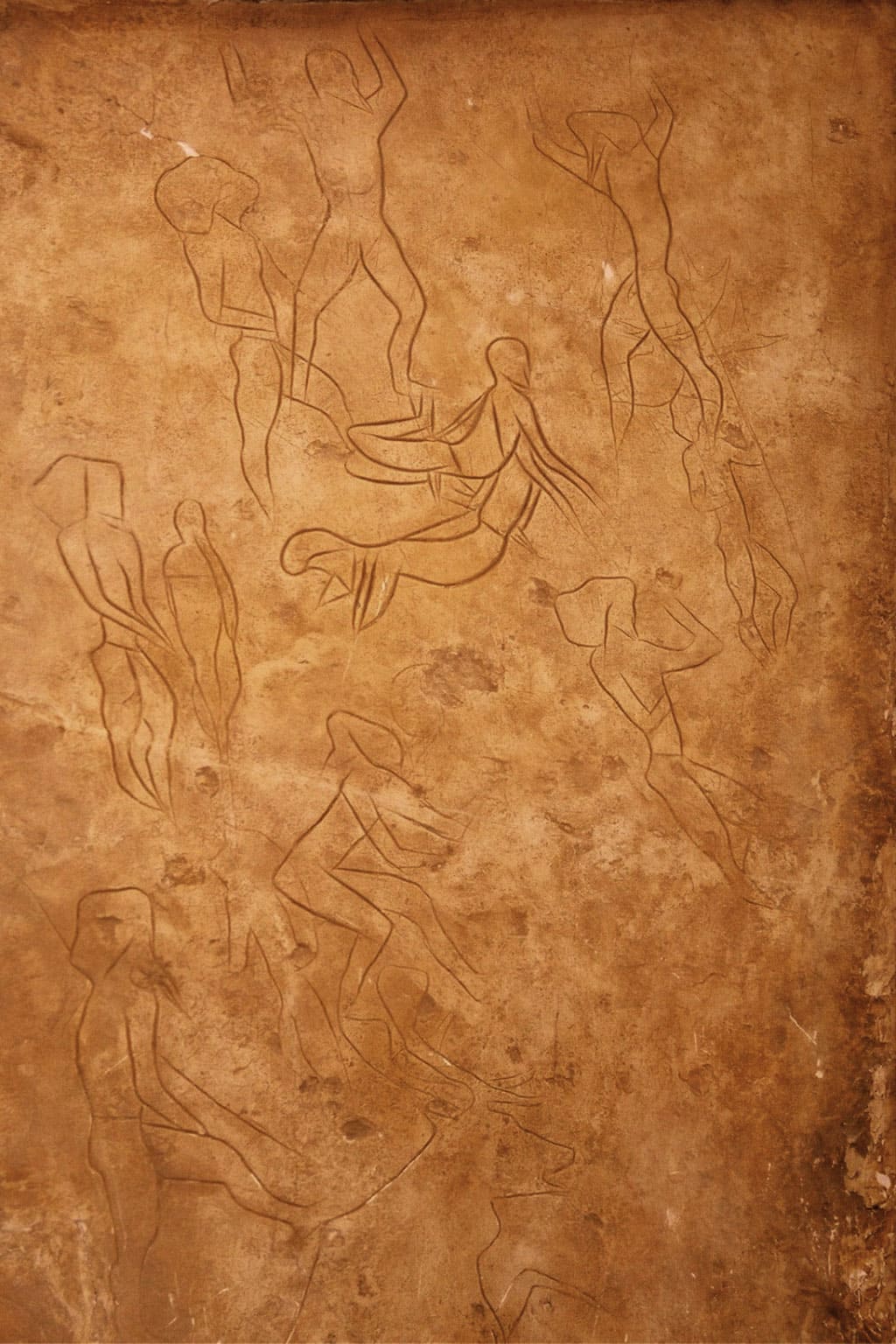
The archaeologist, who discovered the cave in 1952, Jole Bovio Marconi assumed that this was a homoerotic image; a homoerotic ritual for a god or deity.
The depiction of homosexuality in ancient Egypt
During the time of Ancient Egypt, homosexuality was a complex topic.
In the ancient Book of Dead, homosexuality was mentioned as wrong concerning sexual relations. It seemed important not to engage in homosexual acts in places of worship such as temples. The female author of the Book of the Dead writes about not having relations with other females in places of worship:
This suggests that homosexual activities were prohibited in places of worship but somewhat accepted and tolerated in areas outside the religious realm.
Ancient Egyptian literature describes the gods and deities as having same-sex relationships. The book of Dreams mentions sex between women several times.
One of the potential gay couples of Ancient Egypt could be Niankhkhnum and Chnumhotep, two high officials in Ancient Egypt. They both held the title of overseer of the royal manicure.
In 1964, archaeologists in Egypt discovered the tomb of Niankhkhnum and Chnumhotep, two men who lived around 2380 BCE. In the tomb, they would find what could be the oldest existing evidence of queer lives.
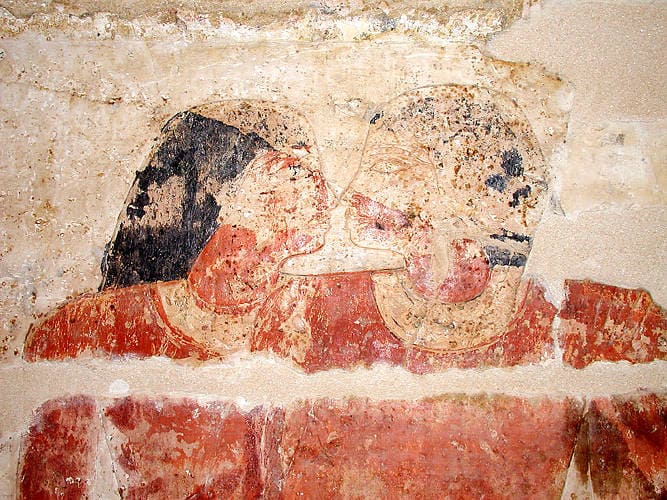
Their period of life is dated to the 5th dynasty (c. 2450-2410 B.C.) during the reign of Niuserre or Menkauhor. They are known today mainly through their joint tomb, in which they are depicted on reliefs in an intimate embrace, kissing, or holding hands.
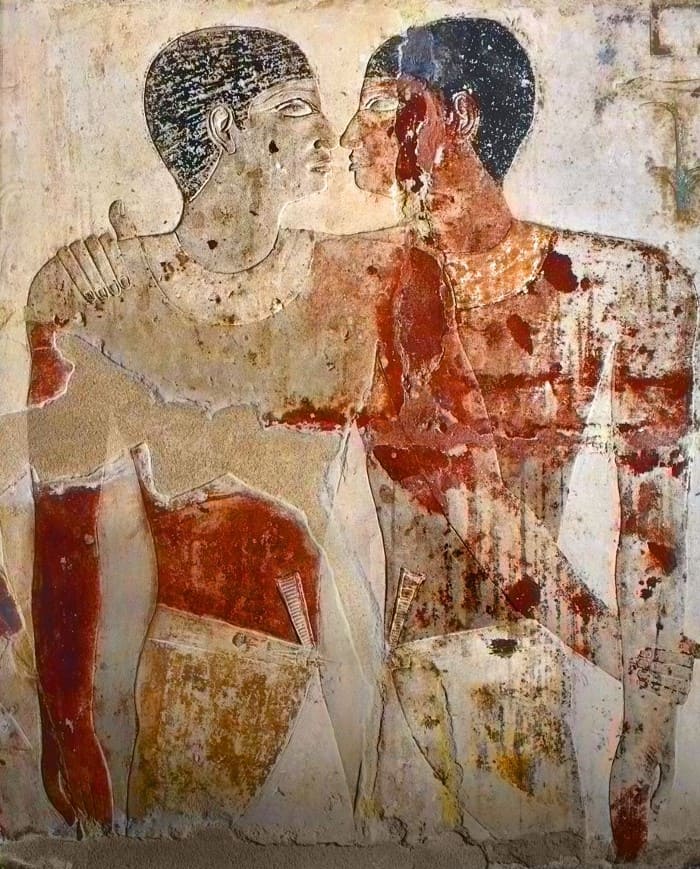
Both men were officially married, but there are no depictions in the tomb of these two men embracing or kissing their wives.
One of the few examples that could be interpreted as the depiction of a lesbian couple is the sculpture of the two Egyptian women, Idit and Ruiu. Both women are depicted in a manner that was traditionally reserved for heterosexual married couples in Egypt.
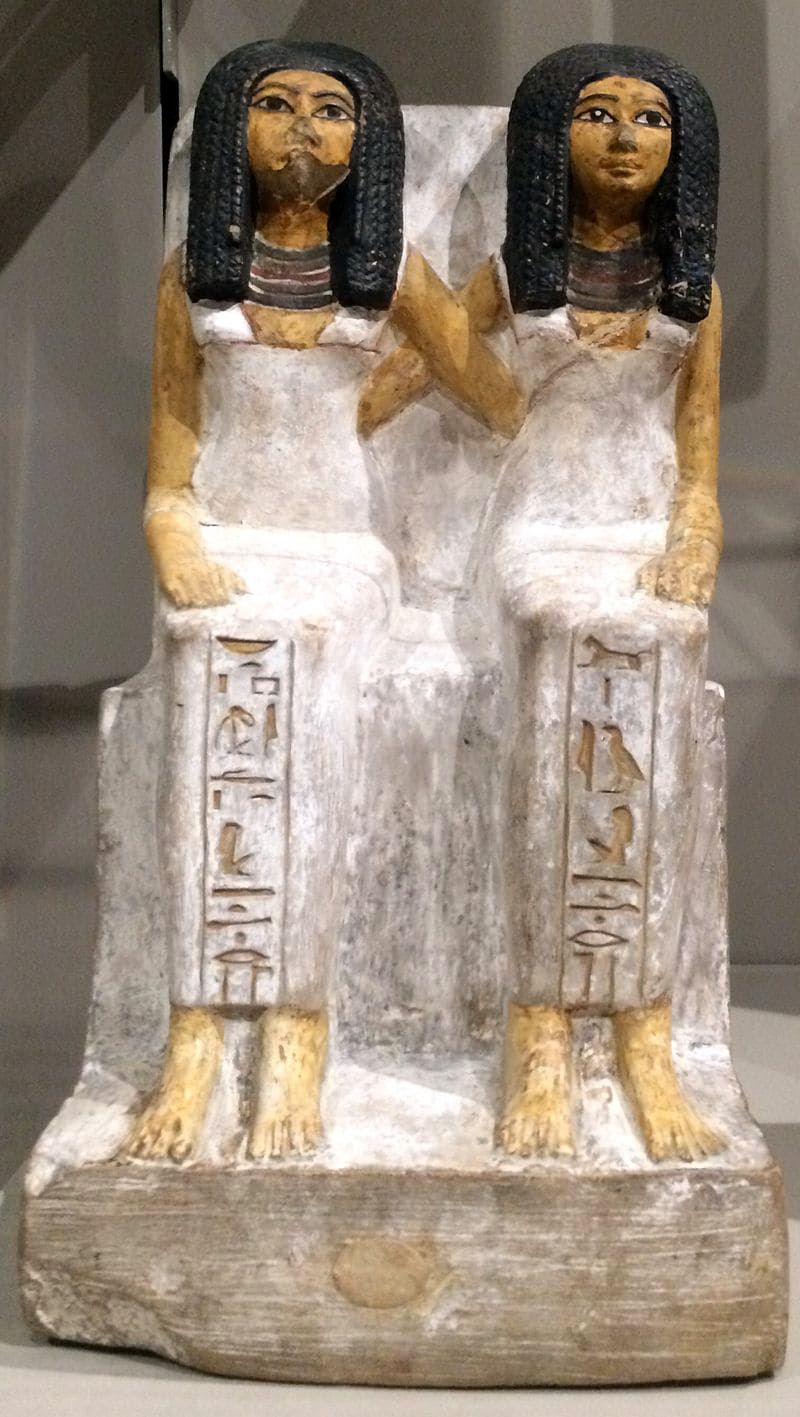
The depiction of homosexuality in ancient Greece
Homosexual relationships played an integral role in Ancient Greece, especially between men.
The powerful ruling class in Greece at the time believed that men who were devoted to each other would be more likely to stand up for each other and fight more courageously. Male love and sexual relationships were used to form elite military units in Sparta, Corinth, and Crete. For example, in 378 B.C. there was an army unit called the "Sacred Host," also called the "Sacred League of Thebes." The army is said to have consisted exclusively of 150 homosexual couples. This army was considered one of the most brutal and capable armies to have ever existed. The soldiers were specifically chosen for their sexual interest in each other.
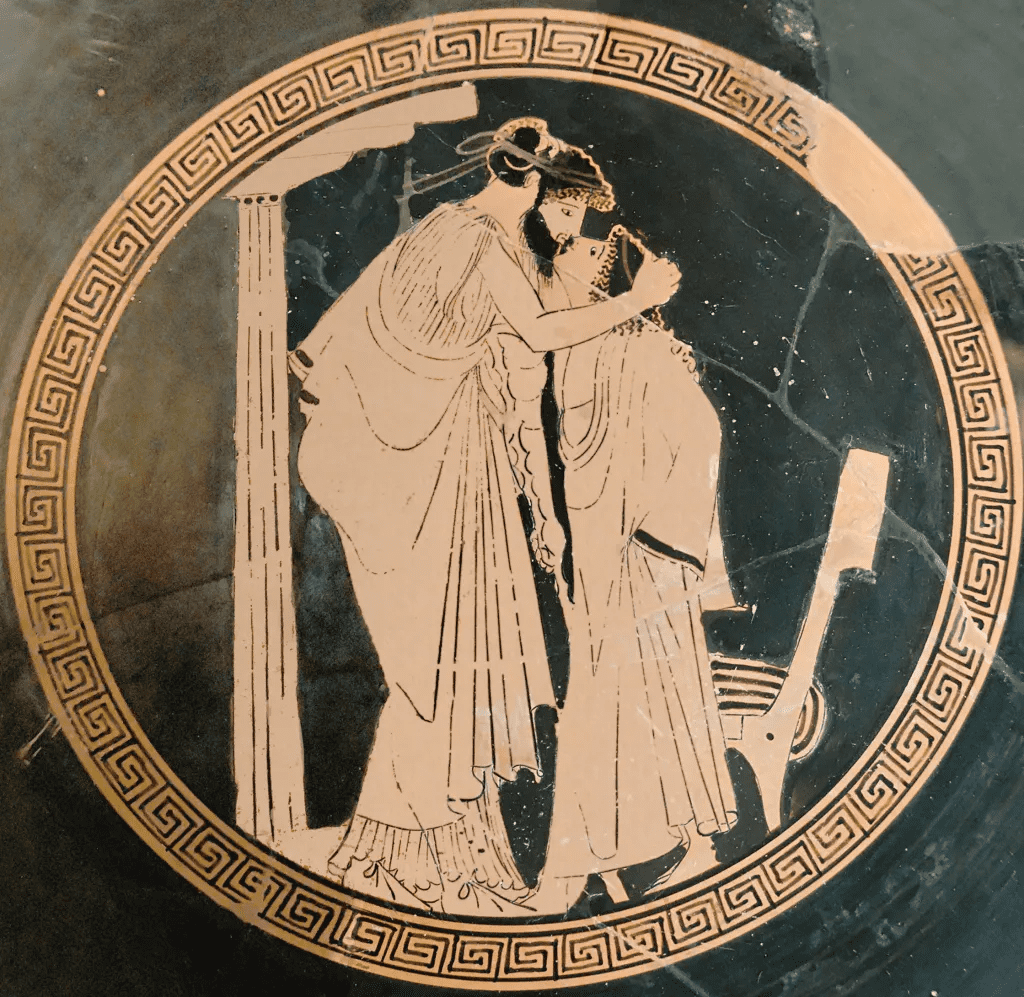
Traditionally, this relationship was between an older man and a younger man. Especially in cities such as Sparta and Thebes, great importance was placed on the relationships between older men and younger men, and they were considered to be an essential part of a young man’s personal development and education.
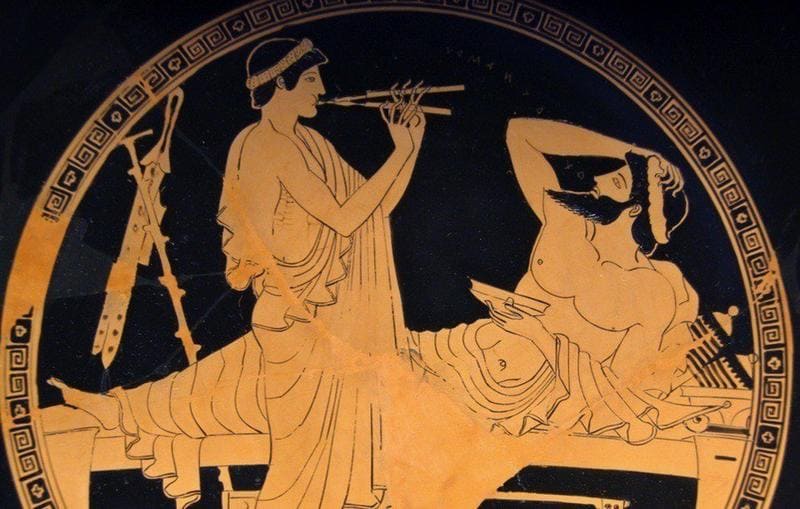
The ancient Greeks did not believe in a heterosexual and homosexual orientation. However, they did believe in passive and active partnerships. The most common form of same-sex relationships was that an older man, the erastes, acted as a mentor and lover to a younger man, the eromenos. It was believed that sperm was the origin of knowledge and that this could be "transmitted. "
The ancient Greeks had no similar concepts that today we call "homosexual," "heterosexual," or "bisexual." The terms "gay," "heterosexual," or "bisexual" are entirely modern conceptualizations that emerged only in the late nineteenth century. These concepts did not fully evolve into the terminologies we know today until the last decades of the twentieth century.
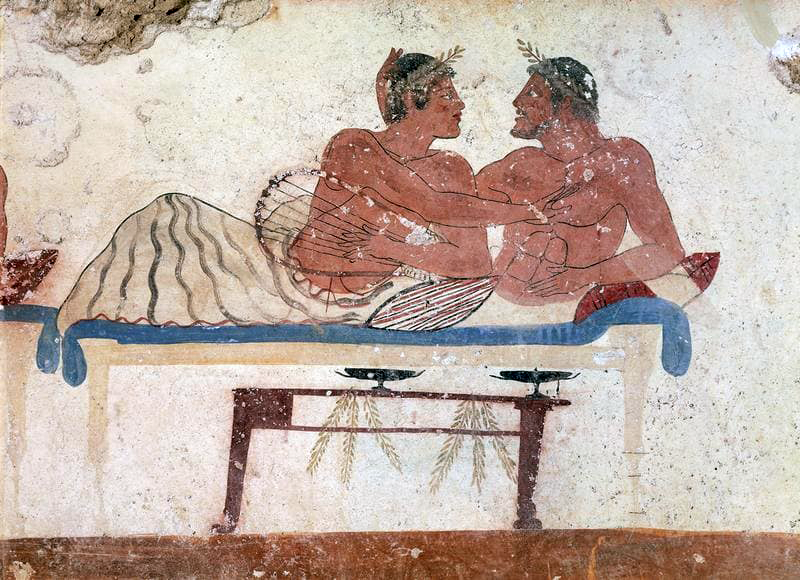
Contemporary scholars, therefore, largely agree that it is inappropriate to classify the people who lived in Ancient Greece with the terms "gay," "straight," "bisexual," or other modern labels. So Alexander the Great was not "gay," "straight," or "bisexual" because those terms did not exist in his lifetime; he may have had sex with women and men, but he would not have called himself "bisexual" or used a similar word with the same meaning.
For the ancient Greeks, there was undoubtedly a difference between homosexual and heterosexual relationships, but they had no concept of a "sexual identity." The ancient Greeks did not consider the sex to which a person was sexually attracted to be a defining, enduring characteristic, but rather an attribute of a particular period in an individual's life. Homosexual acts were considered acceptable only under specific circumstances.
Sappho of Lesbos
The lyric poet Sappho of Lesbos (c. 620-570 B.C.) was so highly regarded in ancient Greece that she continued to be depicted on statues, coins, and pottery for many centuries after her death.
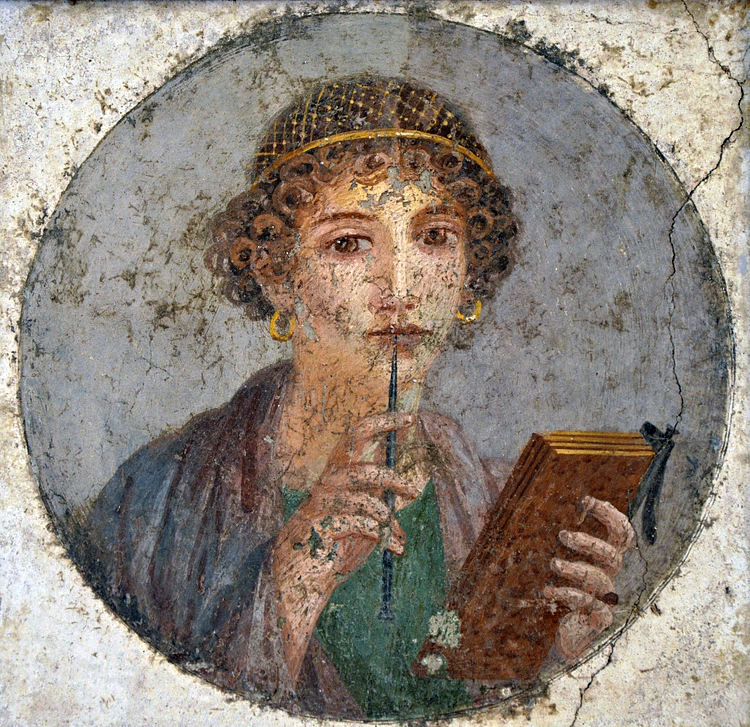
There is little evidence of her work, but these fragments suggest that she was a lesbian. The terms "sapphic" and "lesbian" can be traced back to her name, both of which refer to women's same-sex relationships.
She dedicated many of her poems to female beauty.
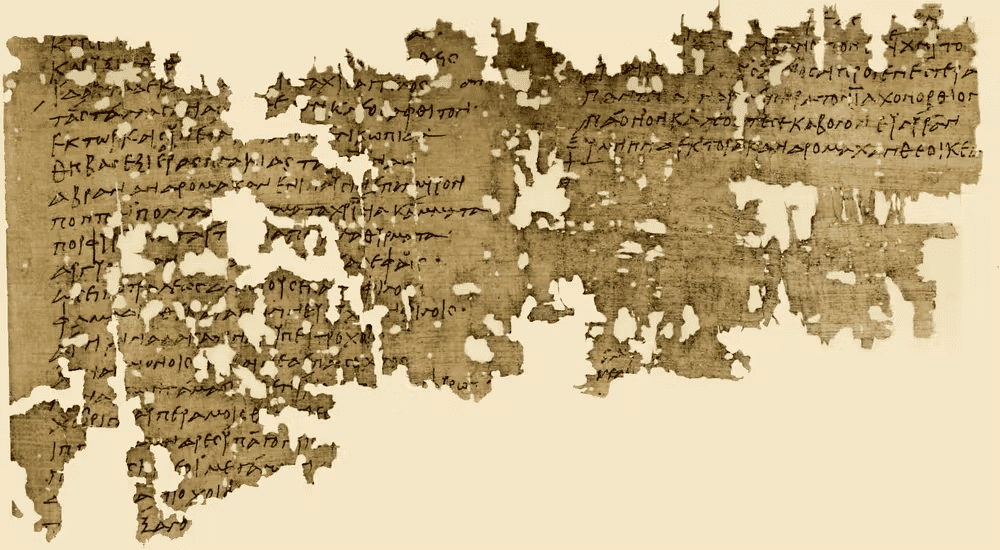
The writers of antiquity, who had access to more of her works than we do today, complimented her on her poetry but criticized her for behaving like a "masculine woman." Almost nothing is known of her life, and of her nine-volume work, which was very popular in antiquity, only 650 lines have survived.
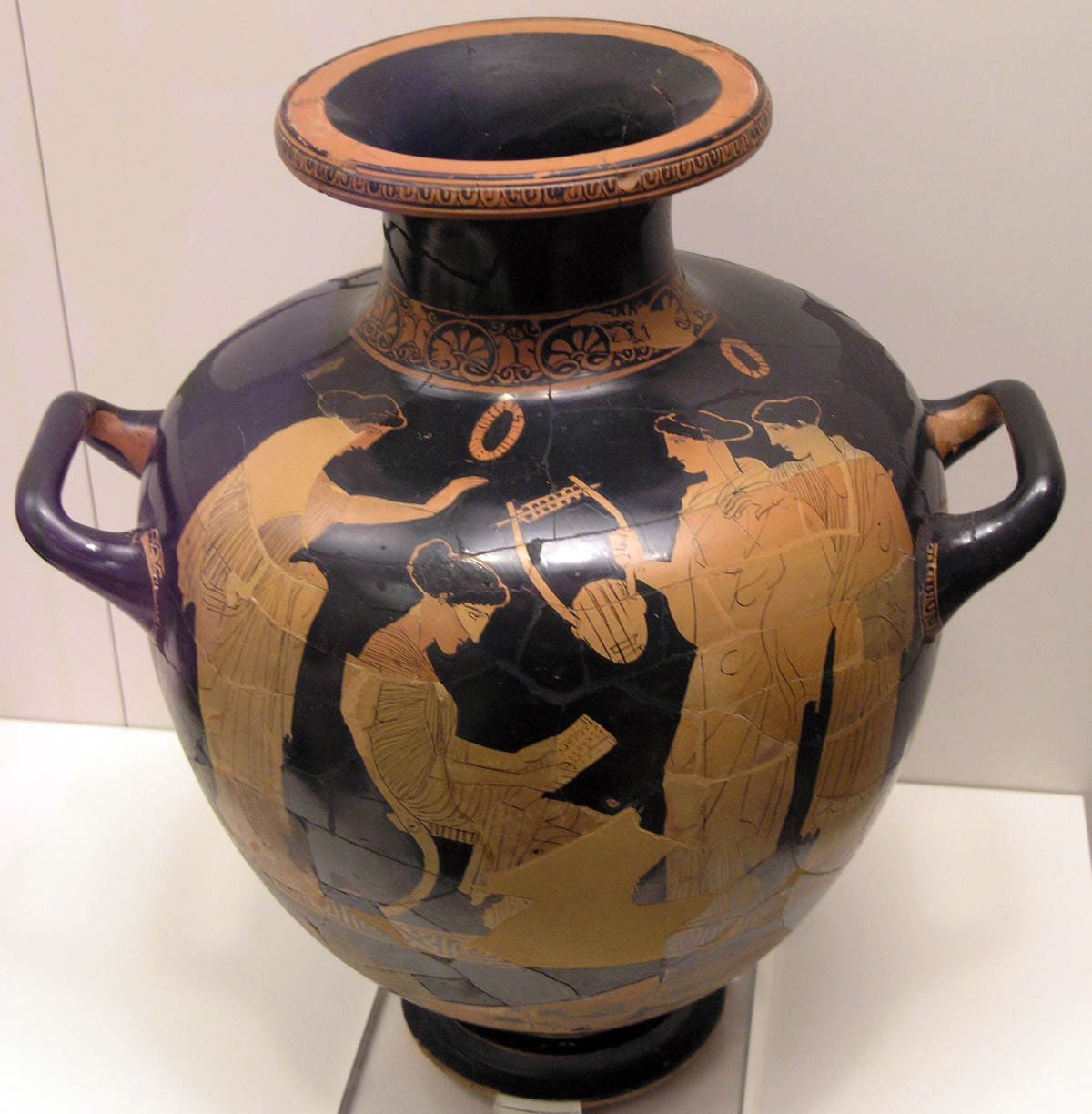
Even Plato (c. 428/427 - 348/347 BC), who dealt with homosexual relationships in his works, praised her highly and, according to some scholars, drew on Sappho for his perception of romantic love. Today, she is considered to be a great queer poet and inspiration to many in the LGBTQ community and beyond.
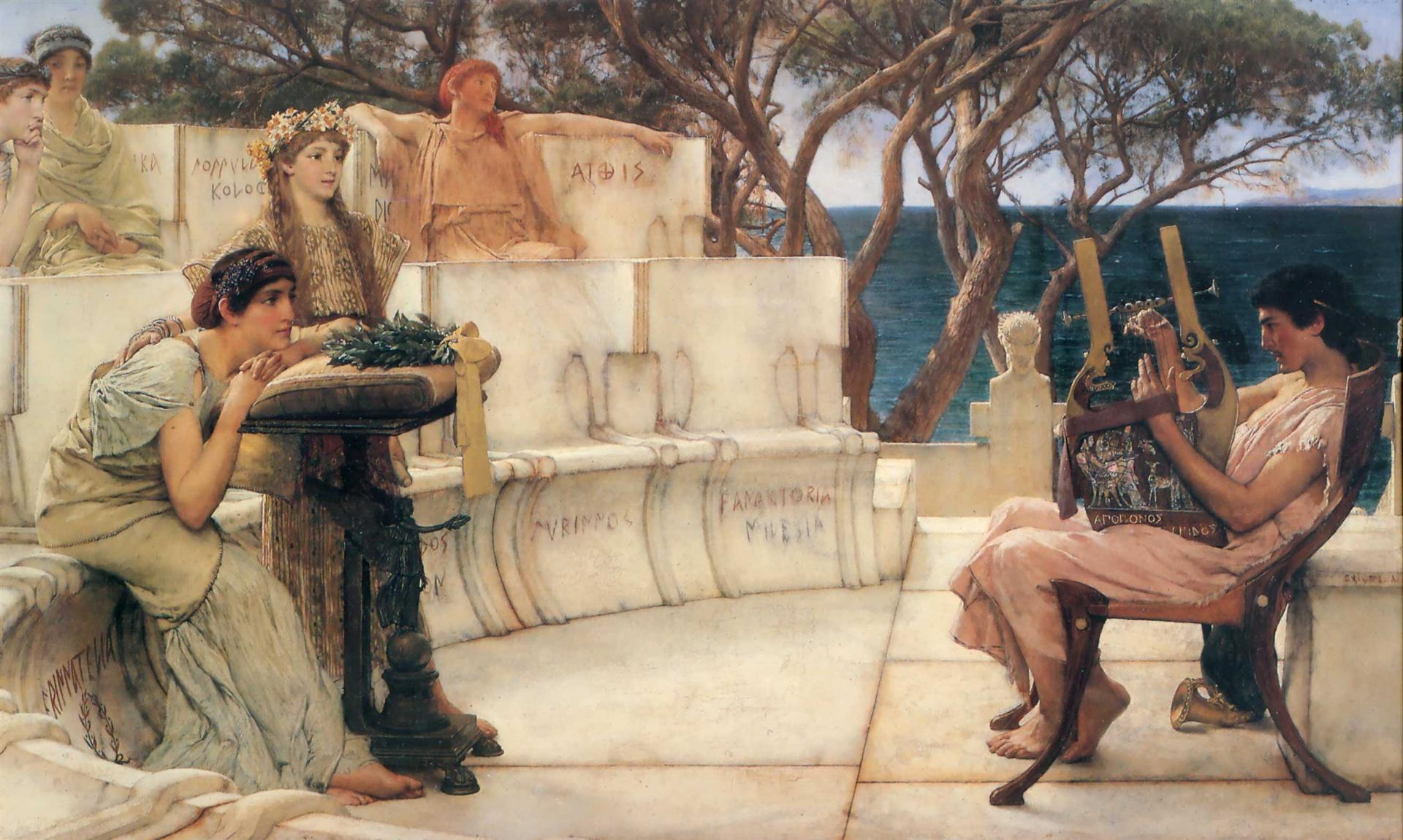
Homosexuality in ancient Rome
Ancient Rome differs significantly from the contemporary West concerning homosexuality. The terms "homosexual" and "heterosexual" do not translate precisely in Latin. The categories of ancient Roman sexuality were active/dominant/male and passive/submissive/female. Roman men were allowed to have sex with other men without losing masculinity or social status, as long as they occupied the dominant or penetrative position.
The terms "homosexual" and "heterosexual" were thus not distinct categories of Roman sexuality, and no words exist in Latin to accurately translate these terms.
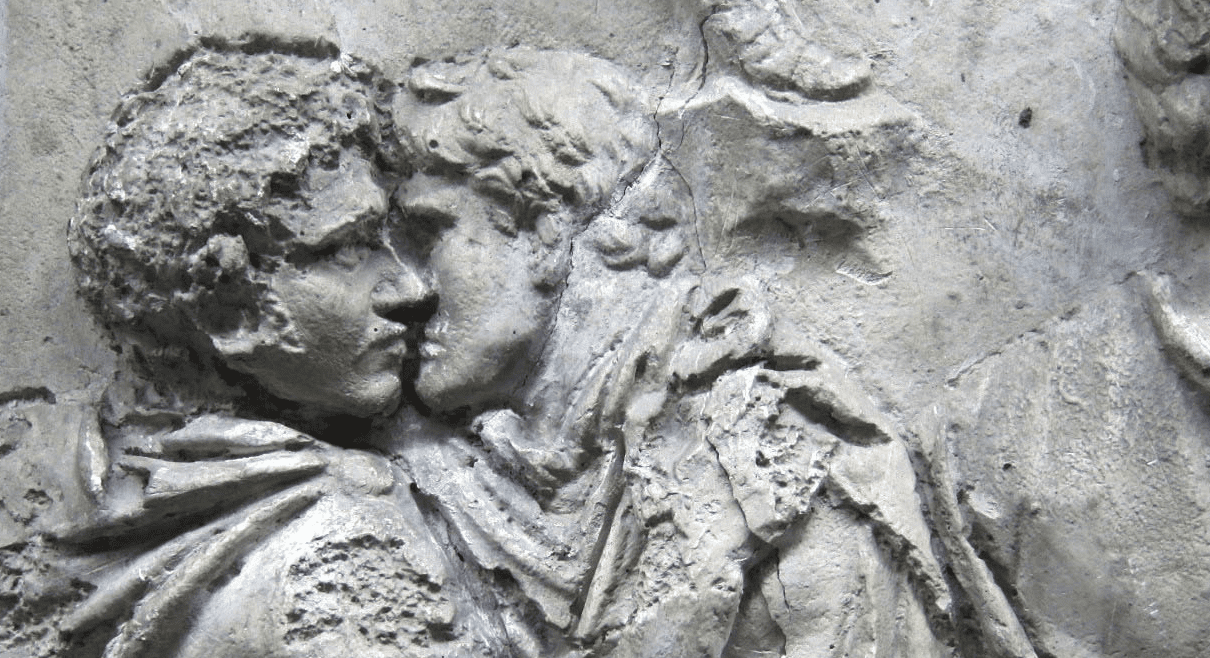
The Roman emperor, considered the initiator of the first same-sex marriage, is said to have been Nero. According to Epitome LXII, 12-13 and several other contemporaries, Nero married with an official ritual ("in modum sollemnium coniugiorum" according to Tacitus). The spouses were first Pythagoras and later Sapporo, who had been castrated because he looked too much like Nero's recently deceased wife, Poppea. The marriage between Nero and Sapporo was celebrated publicly, and he wore women's clothes for the occasion.
According to several chroniclers such as Plutarch and Suetonius, Julius Caesar had a same-sex relationship with King Nicomedes IV of Bithynia.
According to Suetonius, Caesar's troops made fun of him. During Caesar's triumph, the troops sang the following song, "... Caesar subdued the Gauls, but Nicomedes subdued him...".
The emperor Hadrian also had one of the most romantic homosexual relationships in ancient Rome. Antinous was his hunting companion, with whom he made joint trips, journeys, and much more. Hadrian's love for the young Antinous was so intense that after his death, when he drowned in the Nile, he declared him a deity, founded a cult under his name, and erected monuments in his honor.
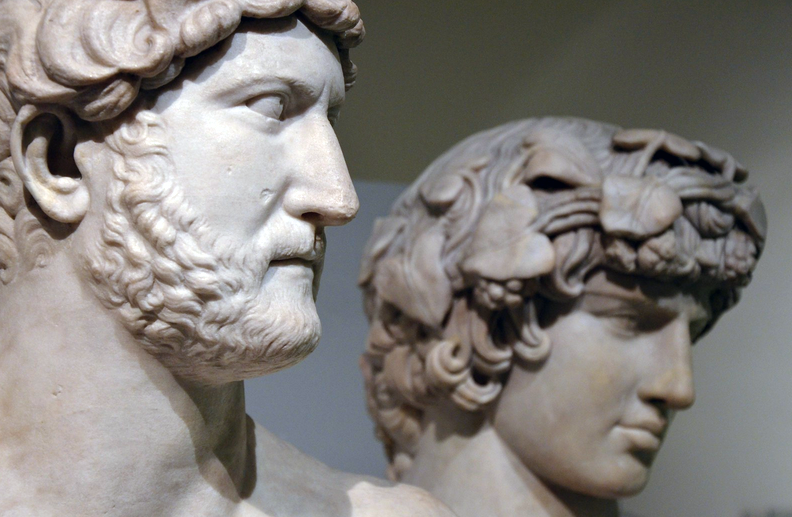
Same-sex relations among women are far less described. If Roman writers are accurate, female erotic love seems to have been rare in ancient Rome. Ovid describes it as "unheard-of." However, there is some evidence—for example, a couple of spells in the Greek Magical Papyri—that attests to the existence of few women in Roman-ruled provinces in the later Imperial period who loved members of the same sex.
Art and homosexuality during medieval times
In the immediate post-Roman period, homosexuality was condemned by the Catholic Church as a sin, for which penance was required.
Homosexual acts during the Middle Ages fell under the category of sodomy. Sodomy at this time meant any sexual act that wasn't "normal." “Normal” in this context meant any sex that did not result in procreation. Sodomy of heteronormative sexual acts usually resulted in much less persecution than acts that were between two people of the same gender. The Church also didn't persecute sodomy until the early thirteenth century.
Bring Your Artistic Vision to Life with Linearity Curve
Transform your creative ideas into stunning artwork. Discover how Linearity Curve’s powerful tools can help you craft beautiful, detailed arts with ease.
From our popular historical understanding of the Middle Ages, homosexuality seems to have been universally denounced by the Church and seen as the moral lesson of the story of Sodom and Gomorrah. However, recent historical work shows us some exceptions to this. In Medieval times, there were also legal arrangements, called adelphopoiesis ("brotherhood") in the Eastern Mediterranean and affrèrement ("fraternization") in France, by which two men could share a dwelling and pool their resources by sharing "a loaf of bread, a wine, and a purse of money." This was a familiar ritual in the Middle Ages. According to historians such as John Boswell and Allan A. Tulchin, these arrangements corresponded to an early form of same-sex marriage. This interpretation of these arrangements remains controversial.
An icon from St. Catherine's Monastery on Mount Sinai in Israel depicts a homosexual couple officially married in a church. The two men on the icon are Saint Sergius and Saint Bacchus, two who were Roman soldiers and later Christian martyrs.
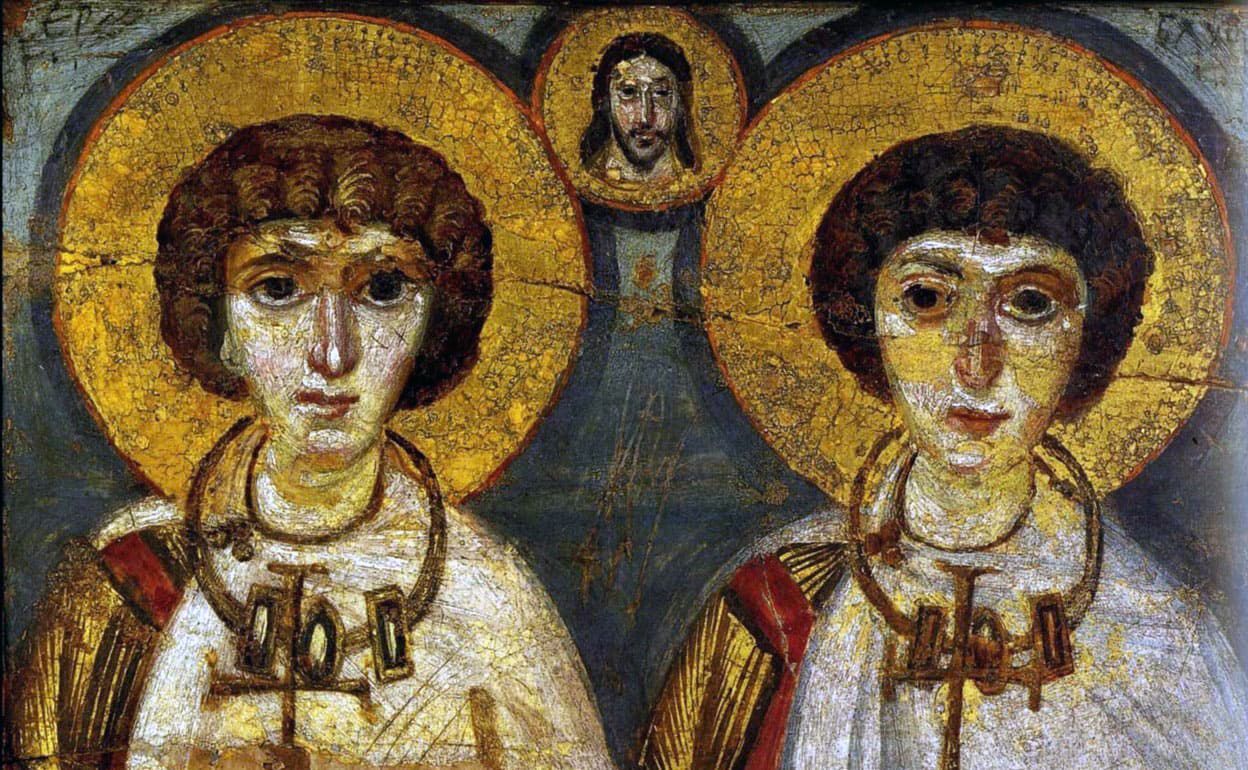
While the pairing of saints, especially in early Christianity, was not uncommon, the partnership of these two men was considered particularly close. The Patriarch of Antioch, Severus (512 - 518 AD), stated that "we should not separate them [Sergius and Bacchus], who were united in life, in speech." This is not a case of simple "adelphopoiia." In the most critical 10th-century account of their lives, St. Sergius is openly referred to as the "sweet companion and lover" of St. Bacchus.
The late Prof. John Boswell, chairman of the history department at Yale University, discovered that in the liturgical documents of the early Christian Church that there were not only opposite-sex marriages but also ceremonies titled "Office of Same-Sex Union" (10th and 11th centuries) and "Order for the Union of Two Men" (11th and 12th centuries).
The depiction of homosexuality during the Renaissance
In the Renaissance era, the wealthy cities of northern Italy—Florence and Venice in particular—were known for their widespread practice of same-sex love, which was practiced by a significant portion of the male population and modeled on the ancient pattern of Greece and Rome. However, even as a large portion of the male population engaged in same-sex relations, a large part of this population was criminalized by the authorities under the direction of the Officers of the Night and punished with fines and imprisonment. Many critical artistic figures of the Renaissance, such as Michelangelo and Leonardo da Vinci, are believed to have had relations with men. The end of this period of relative artistic and erotic freedom was ushered in by the rise of the moralizing monk Girolamo Savonarola.
Michelangelo
As the most important sculptor of the Renaissance, Michelangelo had so much power in the Vatican that he did not have to hide his homosexual relationships. However, Michelangelo left few testimonies about his lovers. The only exception is the erotic statue Victory, modeled after his lover Cavalieri, whom Michelangelo also referred to as his cavalier in his homoerotic poetry. In his later years, Michelangelo liked to "sign" his art by inserting his image into his work, and Victory is an example of this, in which Michelangelo depicted himself between the legs of his model.
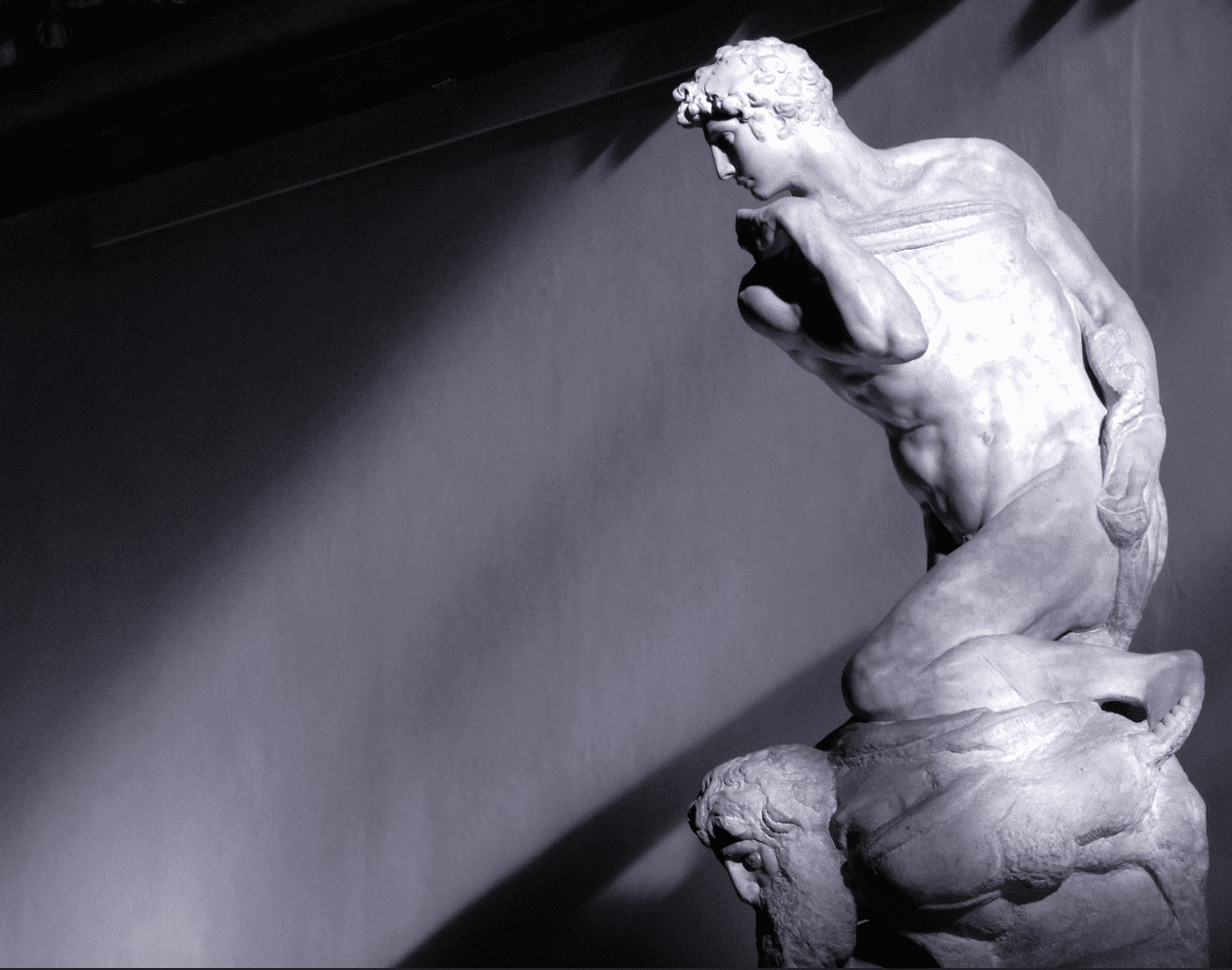
Titian
Among the rare visual testimonies of erotic love and intimate friendship between women is Titian's depiction of Diana with her servants. The painting is about the hunter Actaeon and his meeting with Diana, the goddess of the moon, hunting and fertility (also known as Artemis in Greek mythology) with her servants. The painting shows the hunter before his forced transformation into a stag by Diana because he has waylaid the women. The artwork symbolizes the fear and desire of men to pursue passions that are not meant for them.
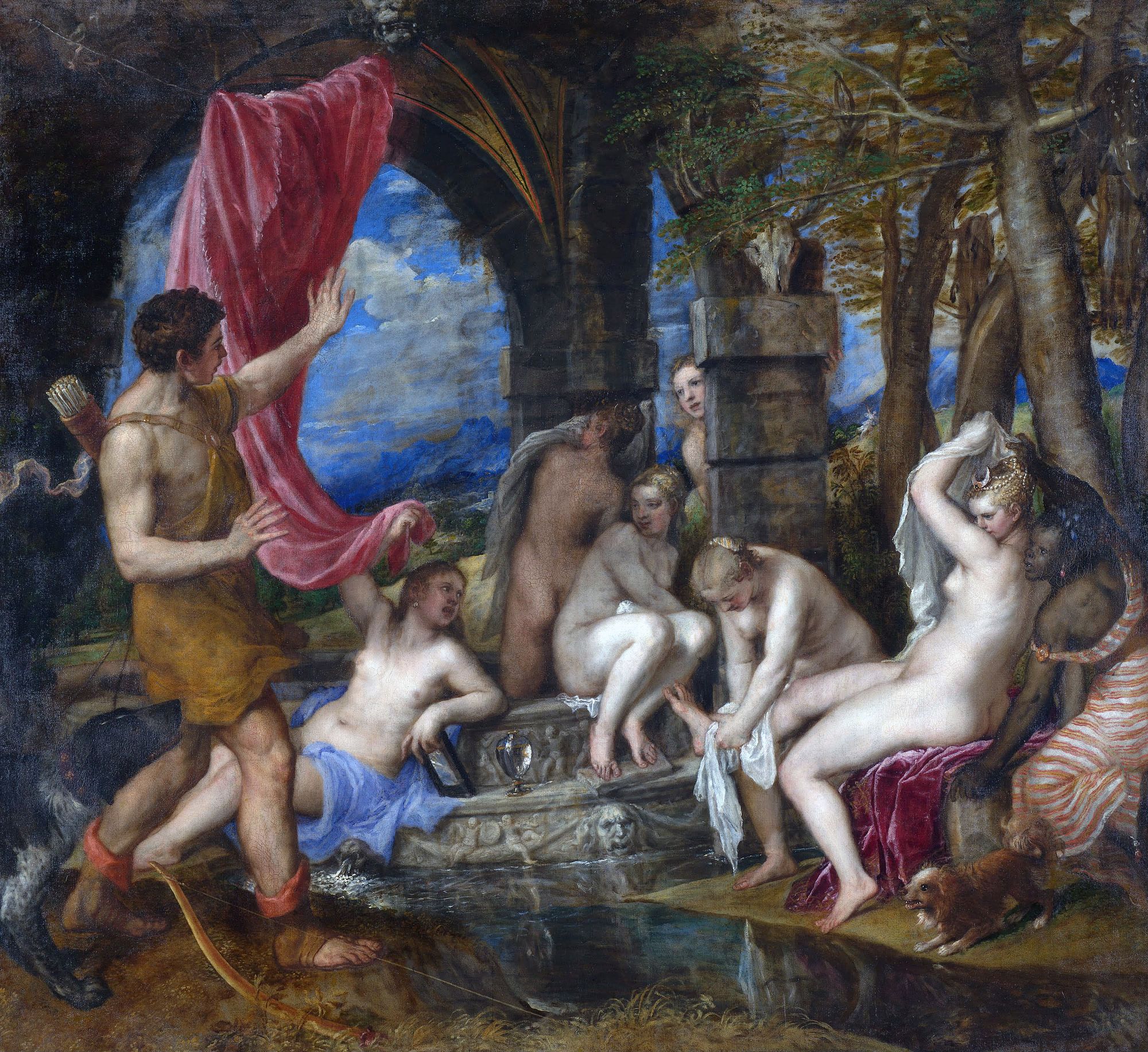
Some of the Renaissance artists placed allusions to homosexual love in their paintings, which could only be recognized at a second glance. The artist Fra Carnevale positioned two homosexual men in the background of his painting "Presentation of the Virgin in the Temple" from 1467.
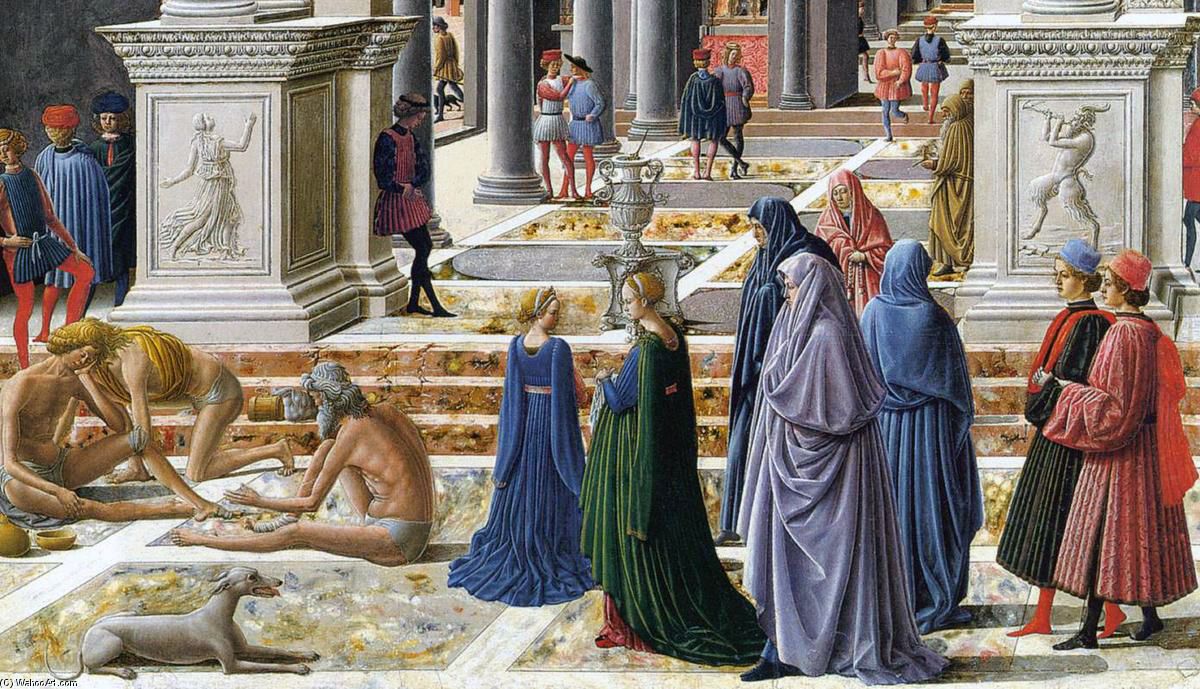
The male couple in the center of the picture symbolizes "temptation" and the gay experience of modern relationships in Florence with their contemporary clothes. The figure on the left (almost halfway down the painting) is touching the other man under the chin in a suggestive manner. This action was considered an erotic gesture and can be understood as a side blow to the innocence of the rest of the scenery, which alluded to the contemporary love lives of young men in Florence.
Caravaggio
Caravaggio's works, characterized by his dramatic chiaroscuro technique (chiaroscuro uses dramatic contrasts of light and dark in which figures emerge from the shadows in a kind of "theatrical limelight"), are sensual and dreamlike. This work, in particular, is about a same-sex happening in music and love, symbolized by Cupido at the left edge of the painting.
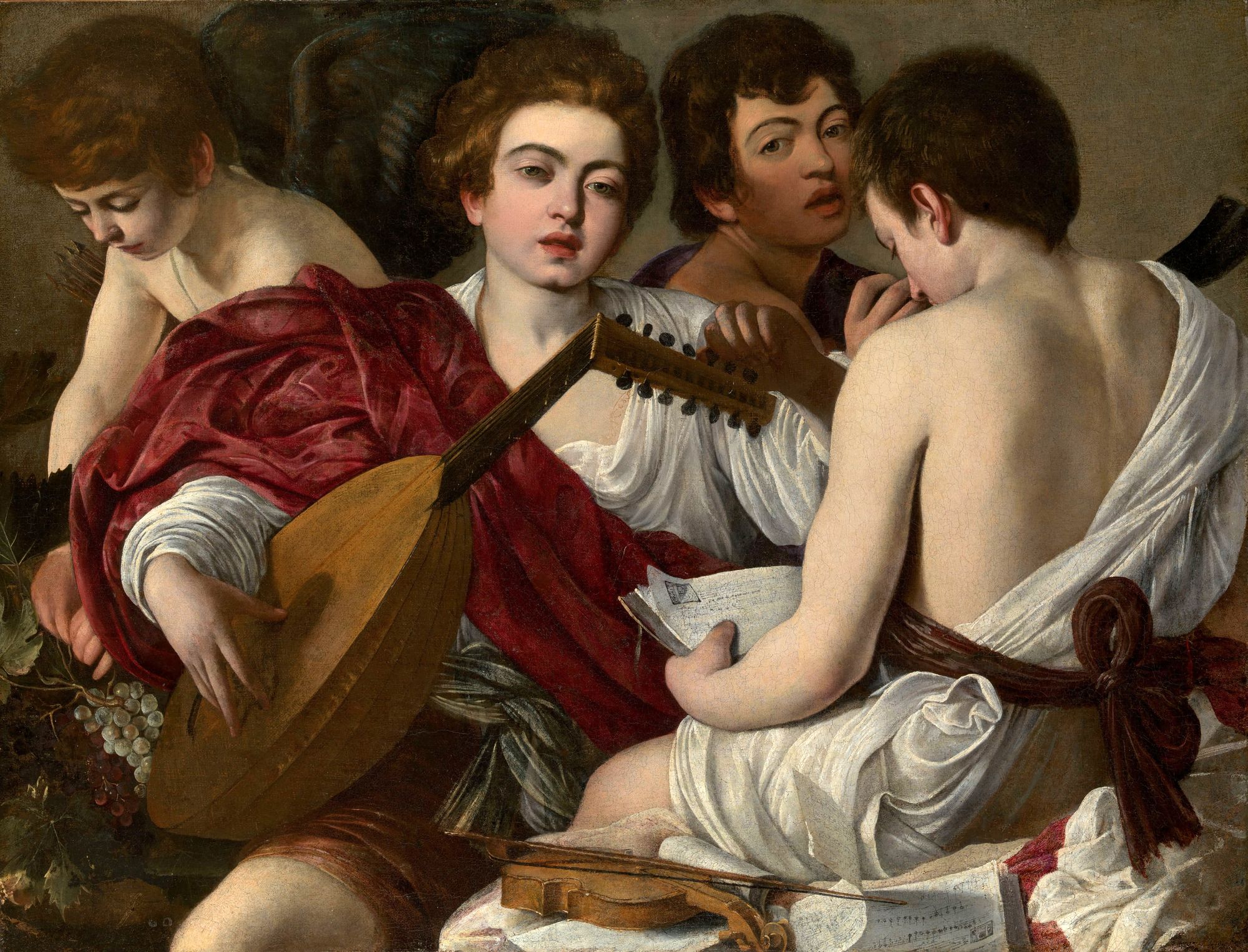
Albrecht Dürer
Albrecht Dürer from Nuremberg was a graphic artist and painter of the German Renaissance. His body of work is considered significant for the German High Renaissance. While studying fine arts, Dürer frequently worked and traveled to Italy and spent time with his reputed companion Willibald Prickheimer, a German jurist and humanist writer. This close relationship was evidenced by numerous letters, which also discussed Dürer's fondness for German girls and soldiers.
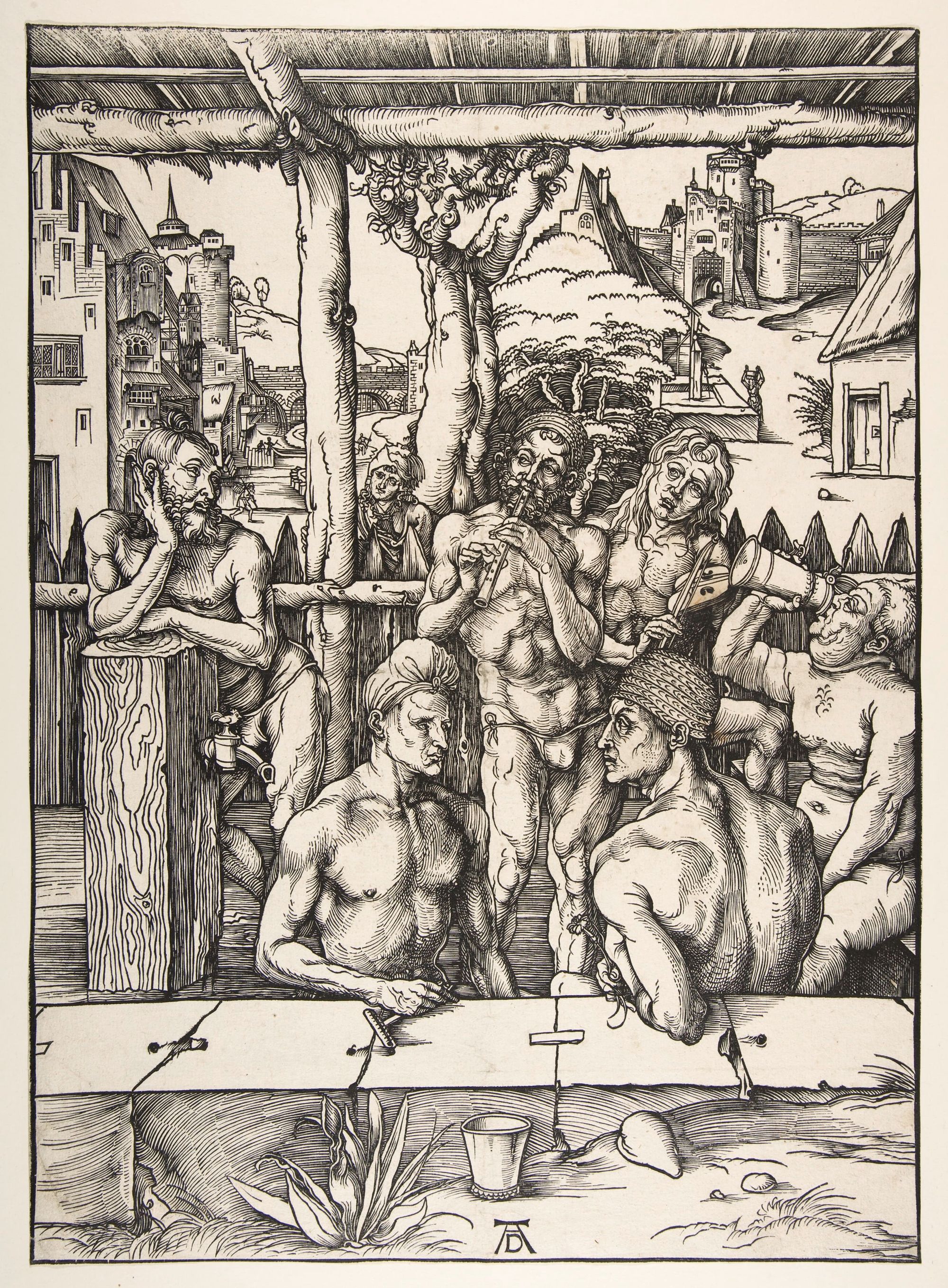
Dürer's bathhouse thematizes a same-sex environment of drinking, music-making, and flirting, and it illustrates, Dürer's experiences in bathhouses and similar spaces. The pictorial language turns out to be homoerotic through the placement of a fountain at the crotch of the man on the left edge of the picture.
Depiction of homosexuality in European art from 1600 to 1870
The famous 1749 novel Fanny Hill by John Cleland contained a homosexual sex scene, but it was removed in the 1750 edition. In 1749, the first detailed and severe defense of homosexuality in English, Ancient and Modern Pederasty Investigated and Exemplified by Thomas Cannon, was also published, but it was immediately banned. In it is the passage: "Unnatural desire is a contradiction in terms; absolute nonsense. Desire is an amatory Impulse of the inmost human parts." Jeremy Bentham wrote another defense around 1785, but it was not published until 1978. Executions for sodomy were carried out in the Netherlands until 1803 and England until 1835.
From 1864 to 1880, Karl Heinrich Ulrichs published a series of twelve tracts, which he summarized under the title Untersuchungen über das Rätsel der männlich-menschlichen Liebe. In 1867, he became the first open homosexual to speak out publicly in defense of homosexuality during the German Jurists' Congress in Munich, where he sponsored a resolution to repeal the anti-homosexual laws.
Sexual Inversion by Havelock Ellis, published in 1896, challenged theories that homosexuality was abnormal and stereotypes and emphasized the ubiquity of homosexuality and its association with intellectual and artistic achievement. [46] Although these medical texts (some of which were written in Latin to obscure sexual details) were not widely read by the public, they provided the impetus for Magnus Hirschfeld's Scientific Humanitarian Committee, which campaigned against anti-sodomy laws in Germany from 1897 to 1933, as well as for a much more informal, non-public movement among British intellectuals and writers, led by figures such as Edward Carpenter and John Addington Symonds.
The European criminal law of the time was that of the old legal system. Homosexuals could be burned in France before the French Revolution, or hanged in Britain. It was also a capital offense in the Holy Roman Empire and Denmark.
Sodomy was a serious crime before the French Revolution. During the first French Revolution, homosexuality was decriminalized in the Criminal Code of 1791 by no longer mentioning same-sex relations in private. This principle regarding private sexual acts was maintained in the Penal Code of 1810 and adopted in the countries and French colonies that adopted this law. However, homosexuality and cross-dressing were widely considered immoral, and LGBT persons continued to be harassed under various public morality and public order laws.
One of the few examples of homosexual love is openly depicted in Emile Jean Horace Vernet's painting. The Battle of Fontenoy in 1745. On the right side, you can see two men kissing passionately.
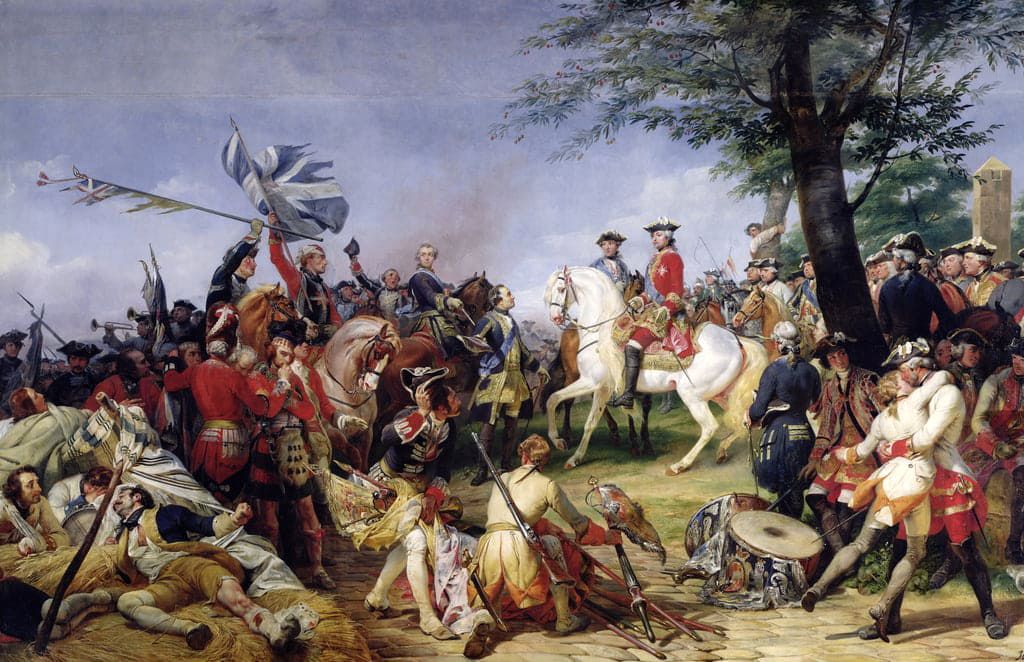
Few love affairs have achieved greater notoriety in English history than that between King Edward II (r. 1307-27) and his favorite from Gascony, the knight Piers Gaveston. The men were so close that the royal court became increasingly concerned that he was neglecting his wife, Isabella of France.
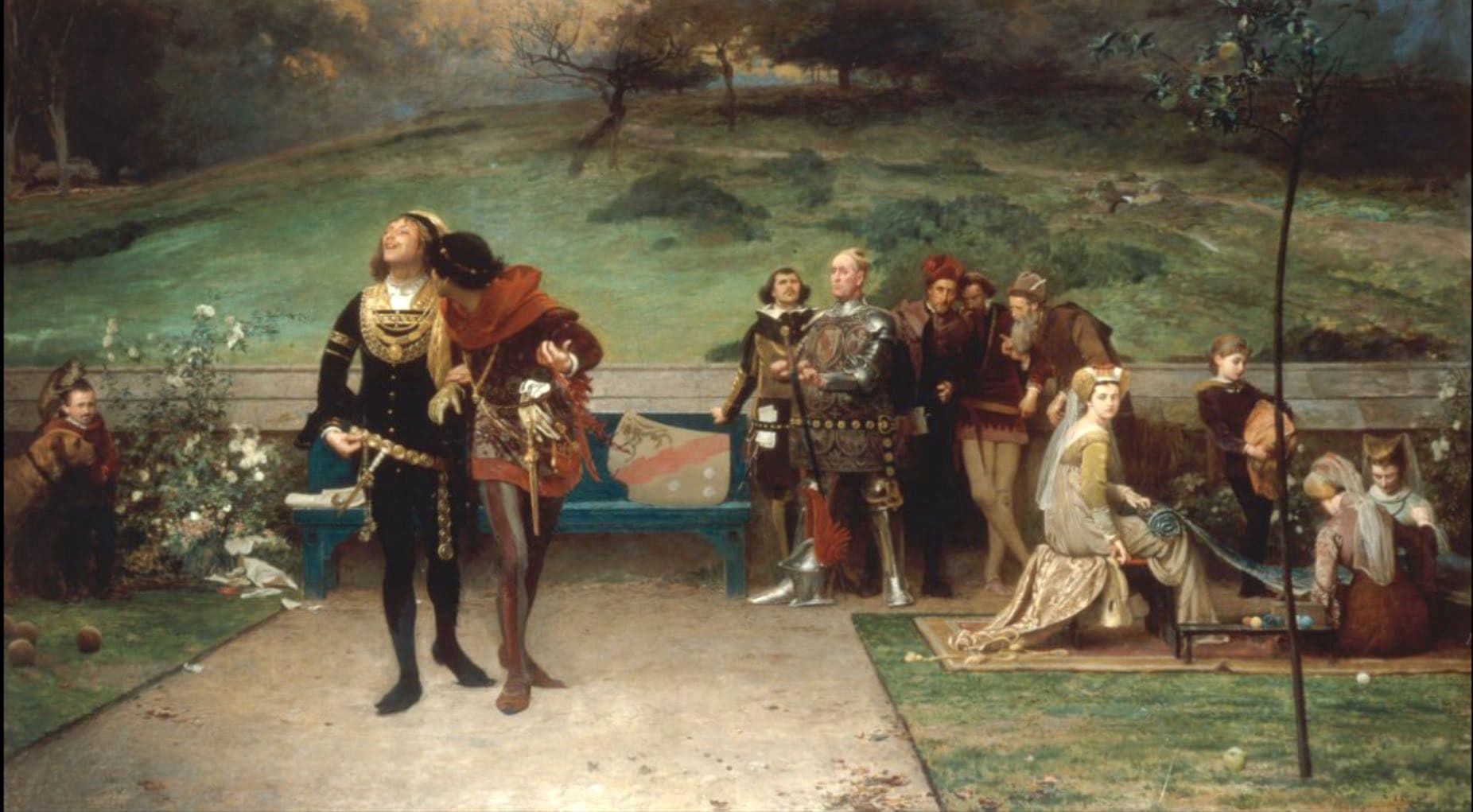
Depictions of homosexual love outside of Europe from 1600 to 1870
This illustration shows Shah Abbas I of Persia and his page boy drinking wine. The intimate imagery shows the page holding the wine flask erect towards the Shah's crotch, and he almost embraces him. In Islam, sex was a positive thing. Sex between men was even considered a "spiritual bliss," albeit not officially condoned. The small Arabic lettering on the right-hand side hints at the joy of wine and love.
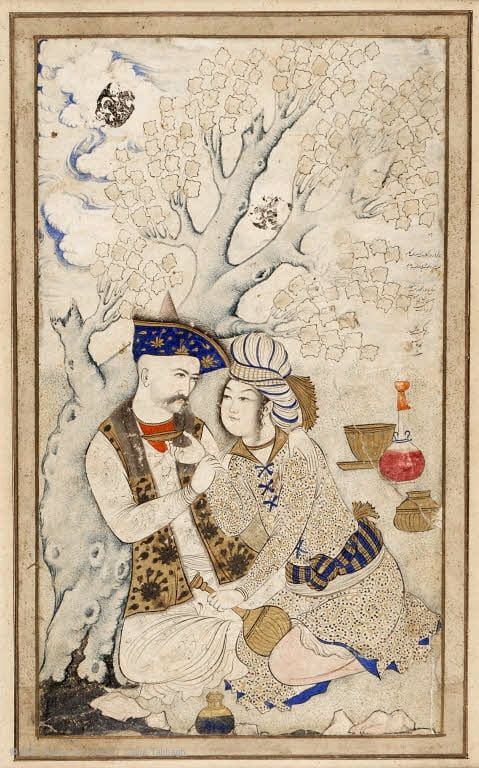
The painter Ustad Ruknuddin was a master at the Rajput court of Bikaner, the city located northwest of the Indian state of Rajasthan, between 1650 and 1697. Maharaja Anup Singh was his patron. Given the historical context, this painting is full of political commentary and represents a blend of Mughal and Rajput painting traditions. The commission was probably to present women as luxuries and as a sign that Anup Singh was an insan-i kamil (an ideal man and ruler).
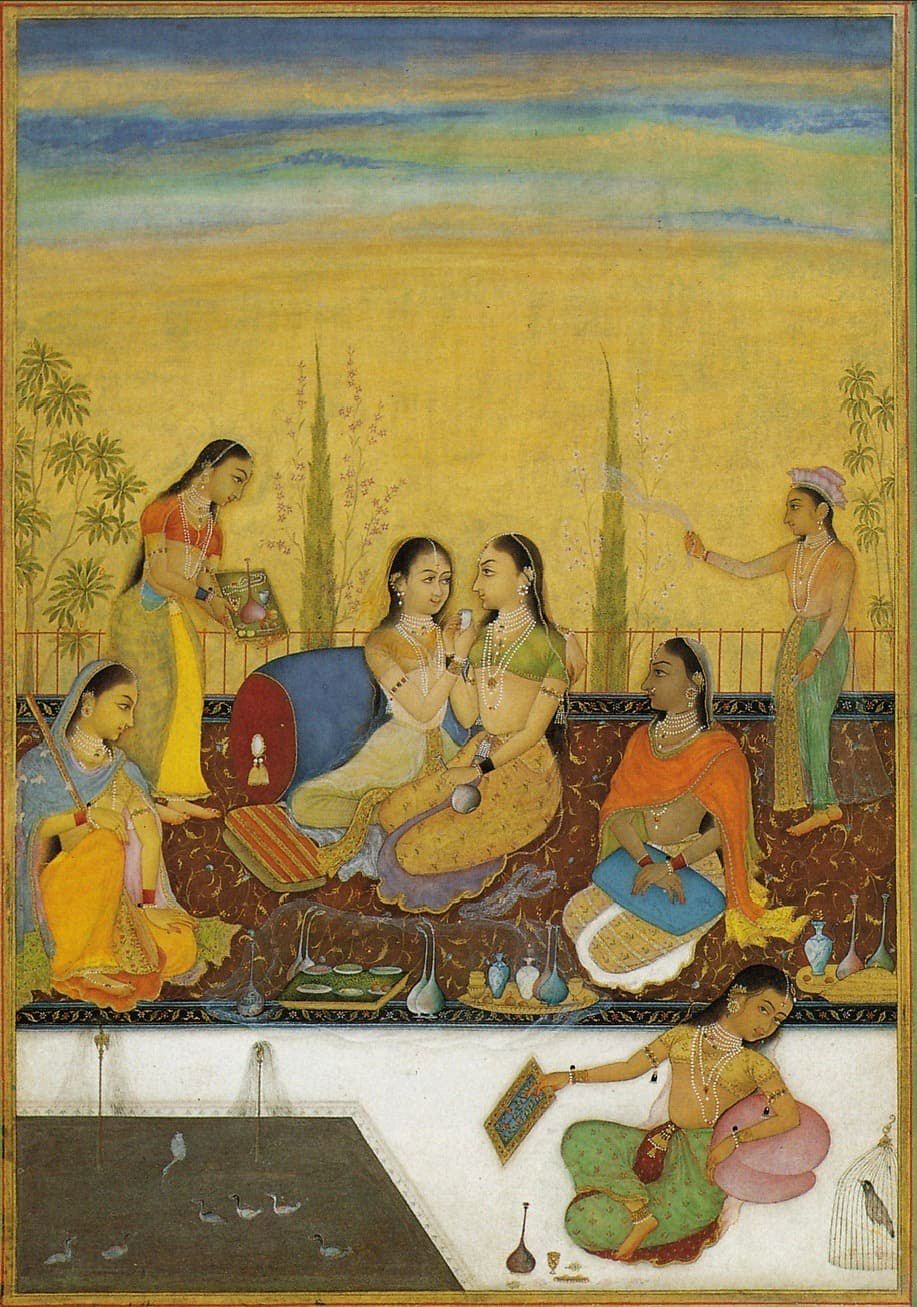
Considering this painting in its historical context, it is well-suited for an analysis of the "male gaze" and men's representation of women for the pleasure of other men, but modern lesbians might also gain access to this 17th-century depiction of intimacy between two women.
The literary sources of ancient India do not explicitly speak of homosexuality. Still, sex changes, third sexes, homoeroticism, and homosexual references are found in the Vedas, the Ramayana, the Kama Sutra, and the Mahabharata. In the Indian epics, many gods are depicted as male and female at different times, and figures of both sexes appear simultaneously in various incarnations.
The temple complex of Khajuraho, built in the 10th century, is most famous for its erotic sculptures on its walls. Also depicted are people of the same sex performing sexual acts.

The depiction of female homosexuality is common, whereas the depiction of male sexual intercourse was not so popular.
Even though the ancient walls, paintings, and inscriptions in India do not directly prove homosexuality, they do show that homosexuality was not perceived as something deviant in pre-colonial times. During British colonial rule in 1860, sexual intercourse between members of the same sex was considered unnatural and declared a crime under Section 377 of Chapter 16 of the Indian Penal Code.
Homosexuality in ancient Japan
The term "Shudo" or "Nanshoku" has been documented for over a thousand years and is associated with the tradition of Buddhist monastic life and samurai culture. From this same-sex love, a culture emerged with significant pictorial and literary representations documenting and celebrating such relationships.
Accounts of Japanese men having sex with men date back to ancient times. Western scholars have taken these accounts as evidence of homosexuality in Japan. These relationships existed in Japan for millennia but appeared most obviously during the Tokugawa (or Edo) period. Historical practices that scholars have identified as homosexual include shudō (衆道), wakashudō (若衆道), and nanshoku (男色).
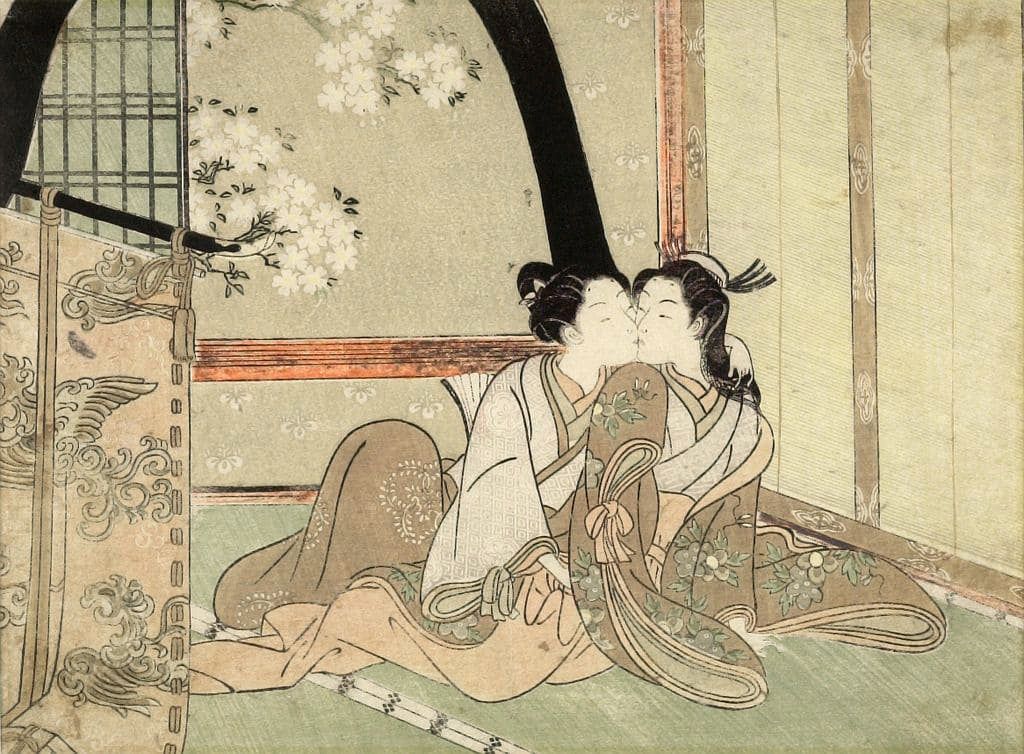
The Japanese term nanshoku (男色, can also be read as danshoku) refers to the Japanese reading of the Chinese characters that mean "male colors." The character 色 ("color") has the additional designation of "sexual desire" in both Japan and China. This term was widely used in the pre-modern era of Japan to refer to sexual intercourse between men. The term shudō (衆道, derived from wakashudō 若衆道, "the way of growing boys") is also used, especially in older works.
During the Meiji period, nanshoku was increasingly discredited by the emergence of sexology in Japan and by the process of Westernization.
Modern Japanese terms for homosexuals include dōseiaisha (同性愛者, same-sex love), okama (お釜, "cauldron," colloquial for "gay men"), gei (ゲイ, gay), homo (ホモ) or homosekusharu (ホモセクシャル, "homosexual"), onabe (お鍋, "pot"/"pan," colloquial for "homosexual women"), bian (ビアン)/rezu (レズ), and rezubian (レズビアン, "lesbian").

Homosexuality in modern art from 1870 to 1970
Homosexuality was illegal in most European countries in the 19th century and was usually referred to as sodomy. Homosexuals still faced severe penalties and social ostracism. Nevertheless, the queer community fought to have their voices heard.
Simeon Solomon
British painter Simeon Solomon (October 9, 1840 - August 14, 1905), who belonged to the Pre-Raphaelites, was known for his depictions of Jewish life and same-sex lust. Due to a public scandal following his arrest and conviction for attempted sodomy in 1873, his career was abruptly ended.

He did not exhibit publicly after his prosecution, yet his work was acquired by such luminaries as Oscar Wilde, John Addington Symonds, Earl Eric Stenbock, and Walter Pater.
J.C. Leyendecker
German-American illustrator Joseph Christian Leyendecker (March 23, 1874 - July 25, 1951) was one of the most revered U.S. illustrators of the early 20th century. His work dates back to the early twentieth century. He is best known for his poster, book, and advertising illustrations, the fictional character "The Arrow Collar Man," and his countless covers for the Saturday Evening Post.
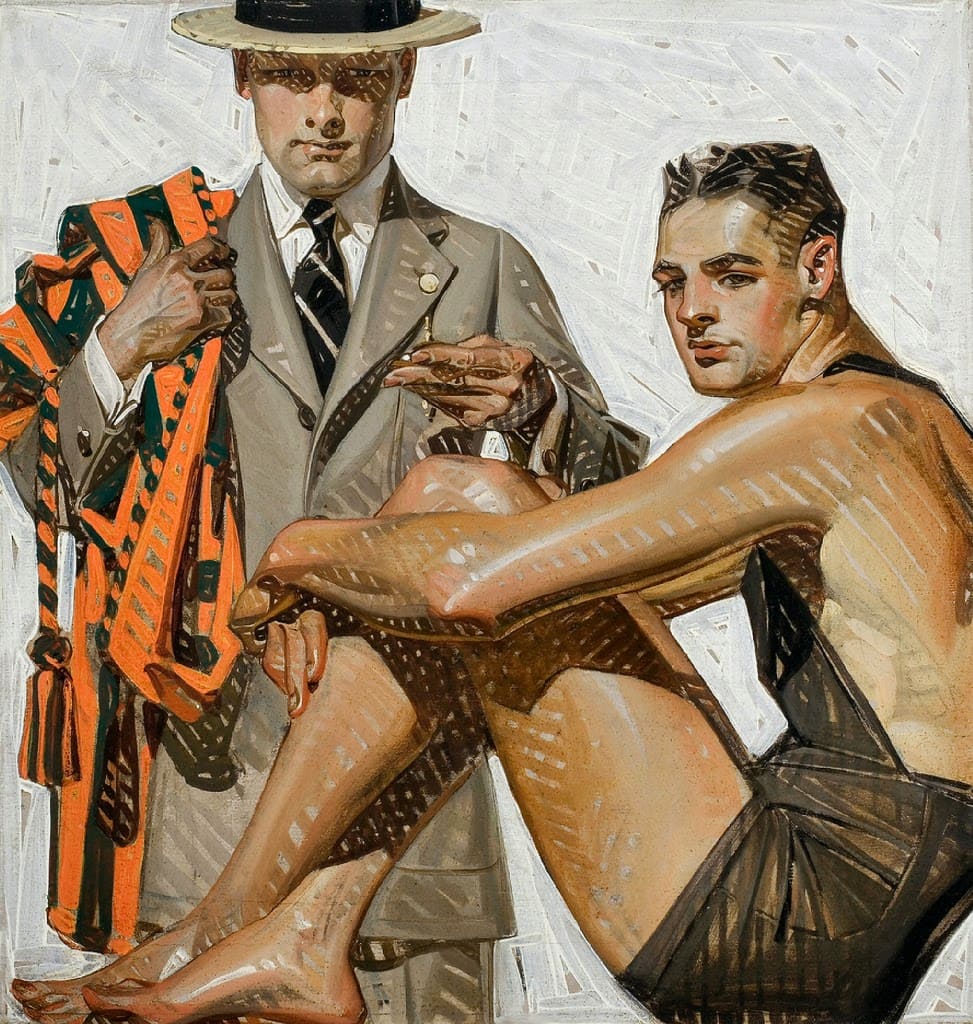
From 1896 to 1950, he illustrated more than 400 magazine covers. For the Saturday Evening Post alone, he created 322 covers and a few advertising illustrations for its interior pages during the Golden Age of American Illustration. He practically invented the whole idea of modern magazine design.
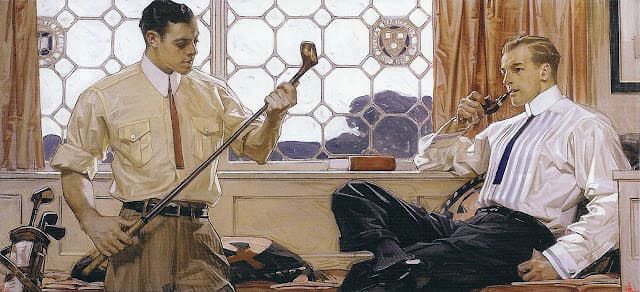
Numerous biographers have puzzled over J. C. Leyendecker's sexuality, often relating the overtly homoerotic aesthetic of his work to a homosexual identity. Leyendecker undoubtedly excelled at depicting masculine lifestyles (dressing rooms, clubhouses, tailor shops) and distinctly handsome young men in outlandish poses or exchanging glances. The artist was never married and lived with Charles Beach, another man, for most of his adult life. He served as a model for the famous Arrow Collar Man and is believed to have been his lover.
Ready to create brand assets that pack a punch?
Visit our Academy for free art design courses.
Leyendecker never openly drew homosexual couples; he only incorporated subtle hints of a homoerotic attraction.
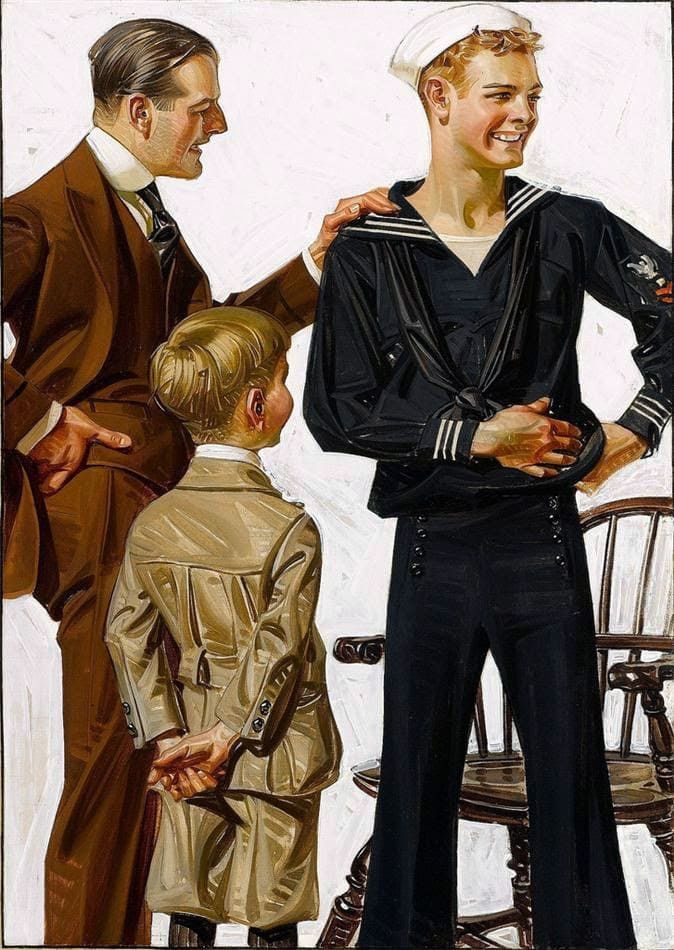
Claude Cahun and Marcel Moore
Sometimes one wonders why certain biographies have not yet been made into films; the life of the photographer Claude Cahun and Marcel Moore are among them. These two were each other’s great loves and were groundbreaking surrealist artists and antifascist resistance activists exploring gender boundaries and different images of gender. Well before concepts of gender and terms such as "non-binary" or "agender" were publicly discussed, Cahun wrote in the autobiography Aveux Non-Avenus:
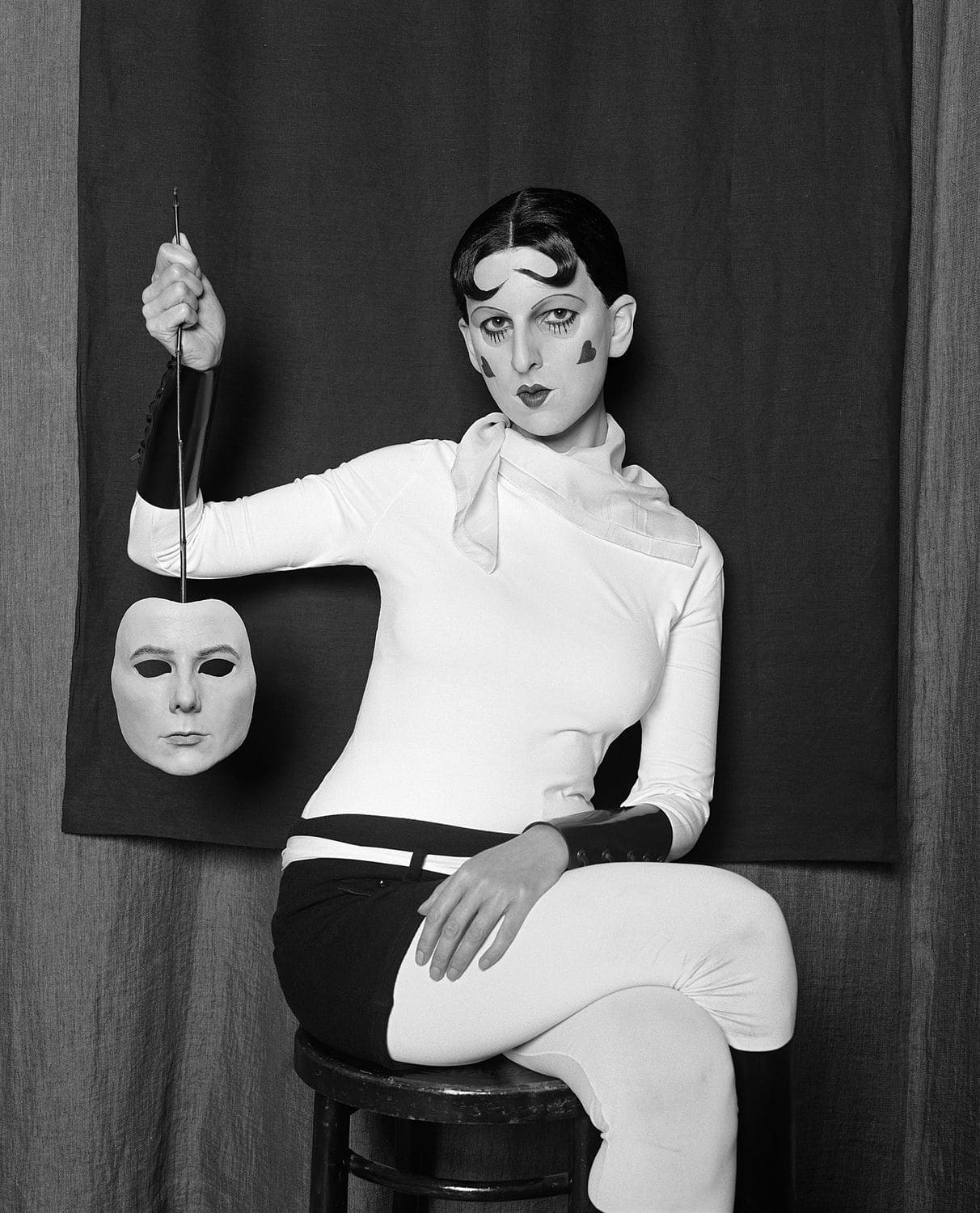
Cahun grew up as the child of a well-off Jewish intellectual family in Nantes, France, and experienced anti-Semitic discrimination at school from an early age. Moore also came from an academic background in Nantes and studied at the art academy. The two met and fell in love in 1909—the beginning of a lifelong artistic, intellectual and romantic relationship. Cahun and Moore moved to Paris in 1922 and interacted with the Surrealist art movement. Due to the sexism of the avant-garde group and its leading figures, they never succeeded in becoming a permanent part of the "Surrealists." However, Cahun's self-portraits, in particular, must be understood as groundbreaking in their genderqueer staging and aesthetic composition.
Francis Bacon
Irish-born British painter Francis Bacon (October 28, 1909 - April 28, 1992) was a figurative painter known for his crude, disturbing images.
His depictions of disfigured bodies and faces were considered extremely disturbing and upsetting for the time. The male nude has always been an essential motif in queer art, as many artists sought to depict alternative versions of love and sexuality. According to Catherine Howe, queer theorist, "In Bacon's work, the male body is both revered and reduced to the status of an animal; it is constrained yet liberated from social conventions of desire." For decades, he explored the theme of wrestlers in different variations. This motif provided optimal camouflage for his sexuality and allowed him to explore the homosexual lifestyle through his art.
Bacon was an openly gay man when homosexuality was still illegal, and his conservative father banished him from his family when he was only 16 years old. Bacon's life and the work he created during his formative years have always been viewed alongside the most unsettling events of the 20th century, as the painter shuttled between Berlin, Paris, and London. Bacon is regarded as one of the most influential painters of the 20th century.
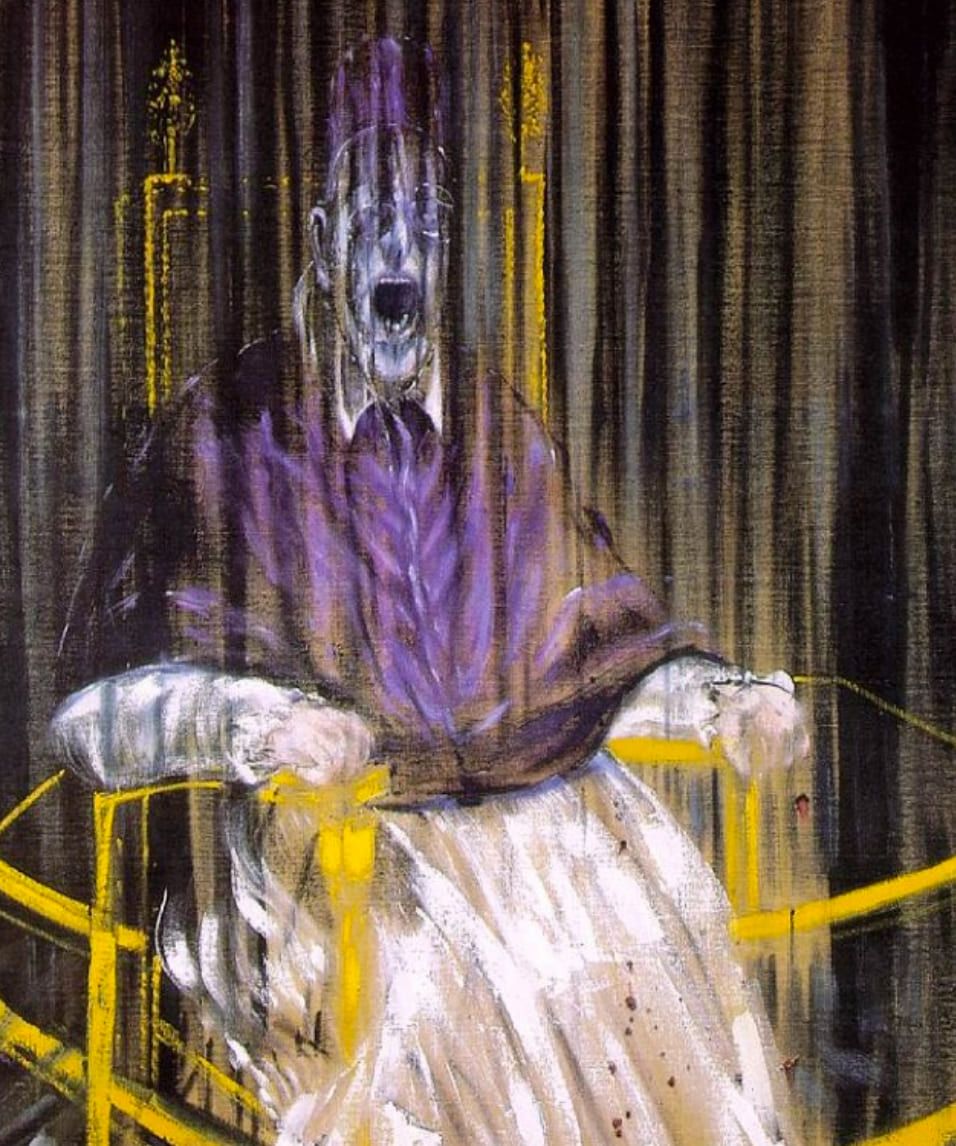
His motifs focused on the human figure and included crucifixions, portraits of popes, self-portraits, and pictures of close friends, with abstracted figures often isolated in geometric structures.
The popes are thought to represent power, Bacon's father, who deeply disapproved of his homosexuality, and the Catholic Church, which violently punished homosexuals but was directed by often homosexual popes.
Hanna Gluck
The lesbian artist known as Gluck was born Hannah Gluckstein in 1895 into a family that owned the Lyon restaurant empire. She defied their ideas about the status of women.
Gluck called her double portrait of herself and her lover Nesta Obermer, Medallion (1936), the "YouWe" painting, and her wedding picture. In 1936, British artist Gluck painted herself and her lover in a radical image of same-sex partnership.
The painting "Medallion" was an uncompromising portrait published in 1936. The artist described it as the couple's "marriage" image decades before gay marriage was universally recognized. She called this public confession of love her "YouWe" image, adding:
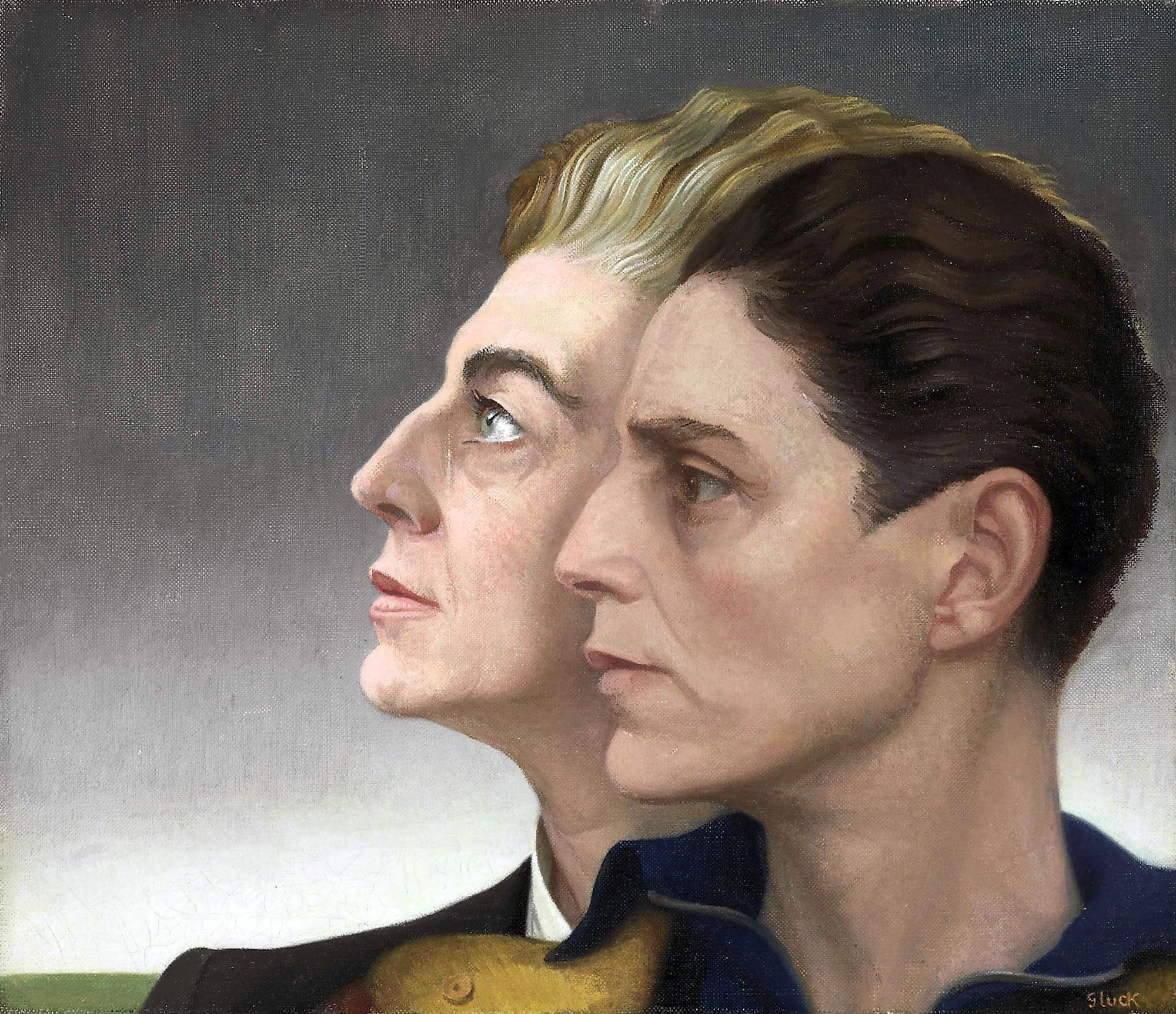
However, the meaning of the work was not discussed at the time. Male homosexuality was punishable by law, and there was no appropriate vocabulary for the term "lesbian" or "transgender."
The rise of Totalitarianism
During the Weimar Republic, gay and lesbian culture and activism were very much alive.
The word "homosexuality" was invented in Germany and first appeared in a German-language pamphlet in 1869. Although the starting point of the movement in Germany dates back to the 19th century, it was not until the Weimar Republic (1919-1933), with its new sociopolitical and democratic freedoms, that gay life experienced an unprecedented flowering.
Although sexual acts between men (women were not mentioned) were still punishable by paragraph 175 of the penal code, gay men and women could express their homosexuality more clearly than ever before. About 50,000 gay and lesbian people lived in Berlin in the mid-1920s. With its countless nightclubs and meeting places for homosexuals, bisexuals, and transgender people, the city became a veritable "Eldorado" for the ever-growing community.
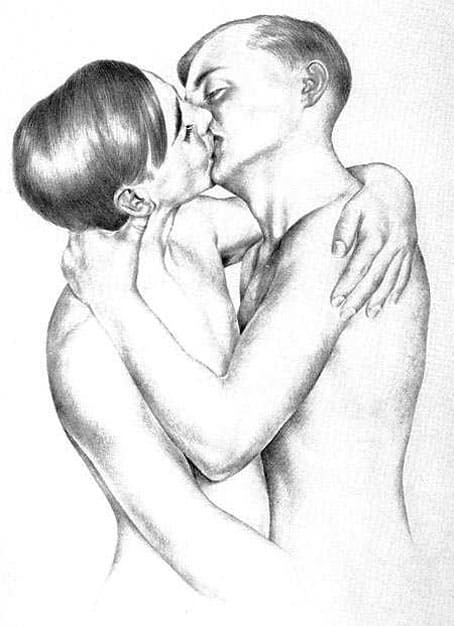
The world's first gay magazine, Der Eigene, was published by Adolf Brand from 1896 to 1932 and featured texts on politics and gay rights, literature, art and culture, and aesthetic nude photography.
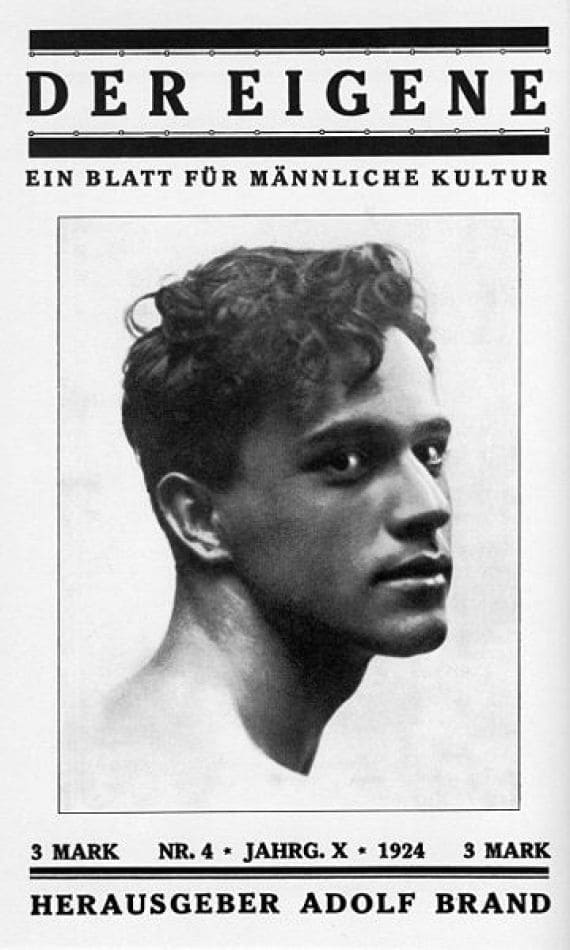
After the magazine "Der Eigene", many other gay magazines followed like Friedrich Radzuweit’s "Die Insel" (The Island) and “Die Freundin ” (The girlfriend).
Amazingly, these publications were publicly displayed and sold on newsstands alongside other newspapers. Included were advertisements and notices for various types of nightspots and meeting places, catering to the particular preferences of their readers.
A difficult time began for the Institute and the German homosexual community after Hitler rose to power in 1933. A few weeks after, the Nazi party initiated the dissolution of gay clubs in Berlin, banned homosexual publications, and banned gay groups; the dissolution of the Institute was the result, and the German LGBT community was not spared the atrocities of the Third Reich.
Get creative with our ready-to-use templates.
Linearity Curve offers templates for every social media platform and various use case templates for posters, business cards, slides, app store screenshots, and more.
The most significant destructive setback occurred when the Third Reich targeted LGBT individuals in the Holocaust.
The establishment of totalitarian regimes and World War II caused a general impairment of civil liberties in Europe, and LGBT persons were regularly sentenced to forced labor.
In the Alsace and Lorraine regions annexed by Nazi Germany in 1940, gay and lesbian people were persecuted and interned in concentration camps. LGBT people were also persecuted under the Vichy government, even though there were no laws criminalizing homosexuality.
David Hockney
David Hockney has been called one of the most influential artists of the 20th century. He is an openly gay painter, illustrator, photographer, graphic designer, set designer, and draftsman.
Hockney began his career with this painting, which is quite different from his later, more realistic style. French artist Jean Dubuffet inspired him to use this almost childlike technique. The work was created towards the end of his second year at the Royal College of Art. Hockney powerfully professed independence with his work: he allowed neither his artistic style nor his sexuality to be dictated to him. British Pop Art later offered him a space where he could purposefully break the rules while deconstructing the linear perspective and accepted social expectations of the time.
In the center of the painting, two figures embrace, kissing as the arm of one encircles the other. The abstract style makes the gender, identity, and facial features of the figures unrecognizable to some degree. Still, the script surrounding the two bodies reads, "We two boys together clinging" The brushstrokes are rough and expressive, contrasting with a soothing color palette of blues, whites, pinks, and reds. All over the canvas are words, numbers, and horizontal lines reminiscent of a staff. It looks like graffiti on a public restroom wall.
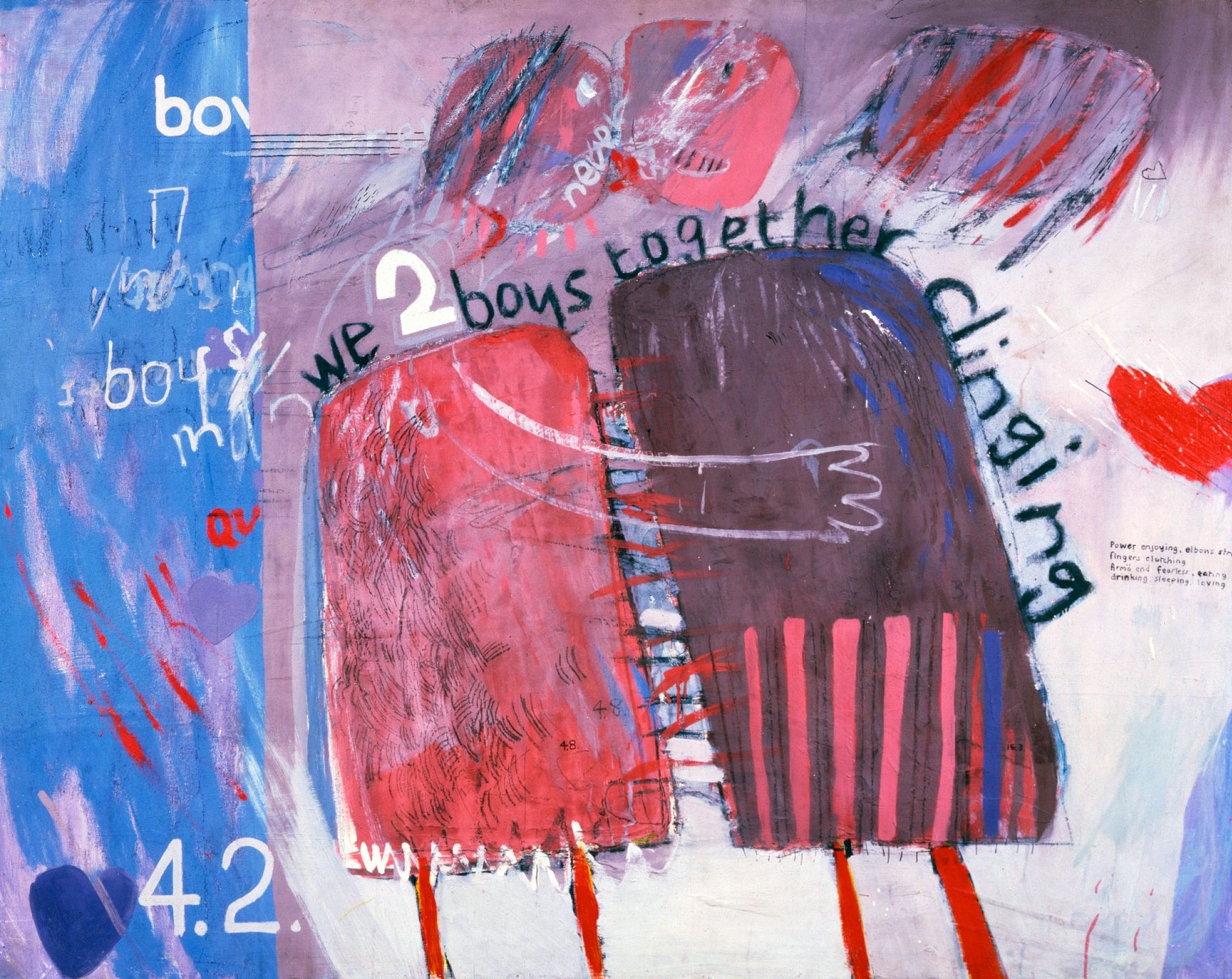
Hockney described his work as "homosexual propaganda" at a time when people had to be careful about being open about their sexuality. He was particularly daring because he was tackling gay sexuality in painting before homosexuality was decriminalized in the United Kingdom in 1967. Hockney often borrowed images from physique magazines that were aimed at gay men.
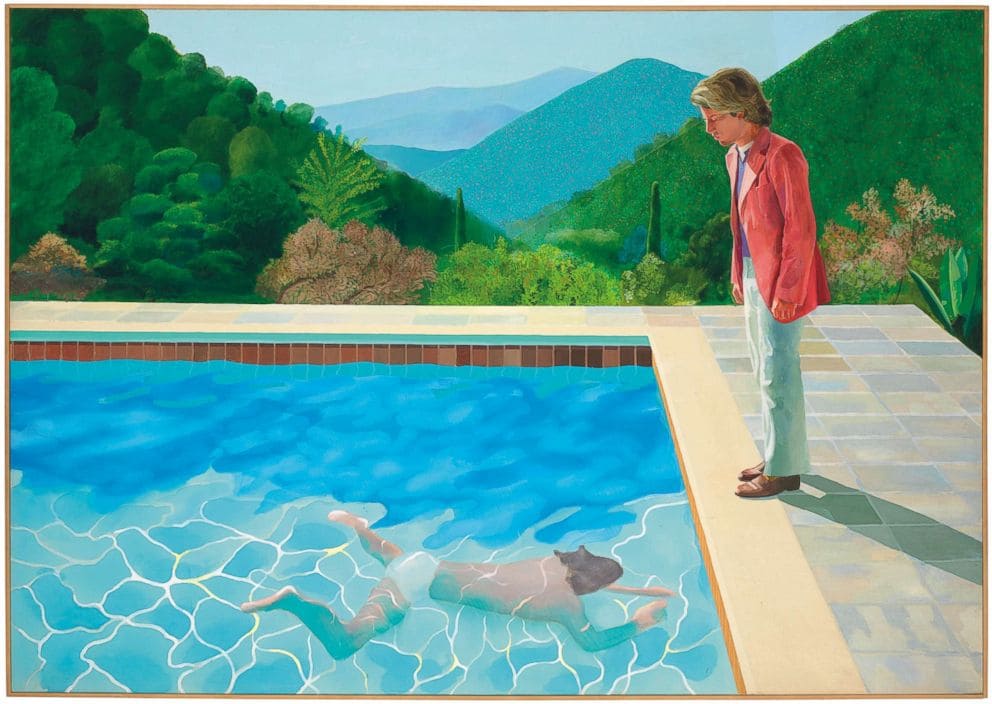
Hockney is best known for a series of paintings of swimming pools he did in 1964 after moving to Los Angeles in the then relatively new acrylic medium.
However, it can be said that David Hockney has much more to offer than swimming pools. For example, these paintings reflect his sunny California lifestyle, while he enjoyed painting the seasons in England.
David Hockney also spent the last few years of his life familiarizing himself with the new technologies available to artists, most notably the Brushes app. He used this to paint still lives, landscapes, and portraits. In an interview with Artnet, Hockney said:
The depiction of queer culture in contemporary art from 1970 to 2022
The turning point: Stonewall Inn
The United States of America was not much different from Europe in the 1960s in that police custody without charge was common for homosexuals. Very few restaurants accepted homosexual people. However, in major cities like New York, clubs that welcomed LGBT people began to catch on.
Living as a homosexual was considered against the law in the 1960s. Openly appearing in public as a homosexual or gender-nonconforming person was considered a disorderly act. Opening a gay bar was prosecuted by law because of these regulations. A pivotal event in LGBTQ+ history was the Stonewall Uprising, which paved the way for the Pride movement.
The Stonewall Inn, a popular bar in the gay community in Manhattan, was violently stormed by police on June 28, 1969. On that day, the LGBTQ+ community rose against police violence. Even a few days after the event, riots and protests occurred on the streets of Manhattan. This event was a turning point the Pride and LGBTQ+ activism movements in the US.
On June the 28th, 1970, a year after the Stonewall riots, thousands of queer activists and their sympathizers gathered in the streets of Manhattan for the Christopher Street Gay Liberation Day March, the first known gay pride rally. A truly historic moment.
Pride Month is celebrated this month of June to commemorate the events in Manhattan from 1969 to 1970.
The Netherlands became the first country in 2001 to introduce same-sex marriage. Despite staunch opposition from Christian parties, same-sex partners were fully recognized under Dutch law.
In the 1950s and 1960s, the Dutch charity Cultuur en Ontspanningscentrum (Center for Culture and Recreation) was instrumental in developing a gay subculture in Amsterdam. In the 1980s, Henk Krol led the movement for greater tolerance of the LGBT community. The Dutch Parliament established a commission as early as 1995 to study the possibility of giving same-sex partners equal marriage rights. After only six years, the almost impossible had become possible.
In 2001, the Massachusetts Supreme Judicial Court ruled in Goodridge v. Department of Public Health that same-sex couples can legally marry, three years later, Massachusetts became the first state to legalize gay marriage—a decision that, unlike Hawaii's, could not be reversed by voters. The state began issuing marriage licenses on May 17, 2004, to same-sex couples, making gay marriage legal across the country (minus state benefits).
Subsequently, the U.S. Senate blocked a constitutional amendment supported by President George W. Bush to ban gay marriage nationwide.
For couples in many other states, 2004 was also notable, but for the opposite reason: a total of ten typically conservative states, plus Oregon, banned gay marriage at the state level. Kansas and Texas followed in 2005, and seven more states passed constitutional amendments against gay marriage in 2006.
Western Europe has become a beacon of marriage equality at the time of writing. The following countries have granted same-sex couples the right to marry: Lithuania, Austria, Belgium, Denmark, Finland, France, Iceland, the Republic of Ireland, Luxembourg, Malta, the Netherlands, Norway, Portugal, Spain, and Sweden.
Andy Warhol
A successful magazine and advertising illustrator, Andy Warhol became one of the leading artists of the 1960s Pop Art movement. Major museums such as the Brooklyn Museum of Art displayed his masterpieces. He explored a variety of art forms, including performance art, films, and video installations, as well as writing, and controversially blurred the lines between fine art and mainstream aesthetics.
American artist, film director, and producer Andy Warhol, born Andrew Warhola Jr., was a significant protagonist in the Pop Art movement known as Pop Art. He explored in his work the relationship between artistic expression, advertising, and celebrity culture that flourished in the 1960s and explored a variety of media, including painting, silkscreen, photography, film, and sculpture. His work ranged from painting to photography to sculpture. Warhol's best-known works include the silkscreen paintings of Campbell's Soup Cans (1962) and Marilyn Diptych (1962), the experimental films Empire (1964) and Chelsea Girls (1966), and the multimedia installations The Exploding Plastic Inevitable (1966-67). Warhol died in New York City on February 22, 1987.
Raised as a Catholic, Warhol struggled to reconcile his conservative and strict upbringing with his homosexuality. This is expressed in his artwork Raphael Madonna-$6.99, 1985. It was a part of his series Revelation, in which he criticizes the relationship between the Old Masters and pop culture.
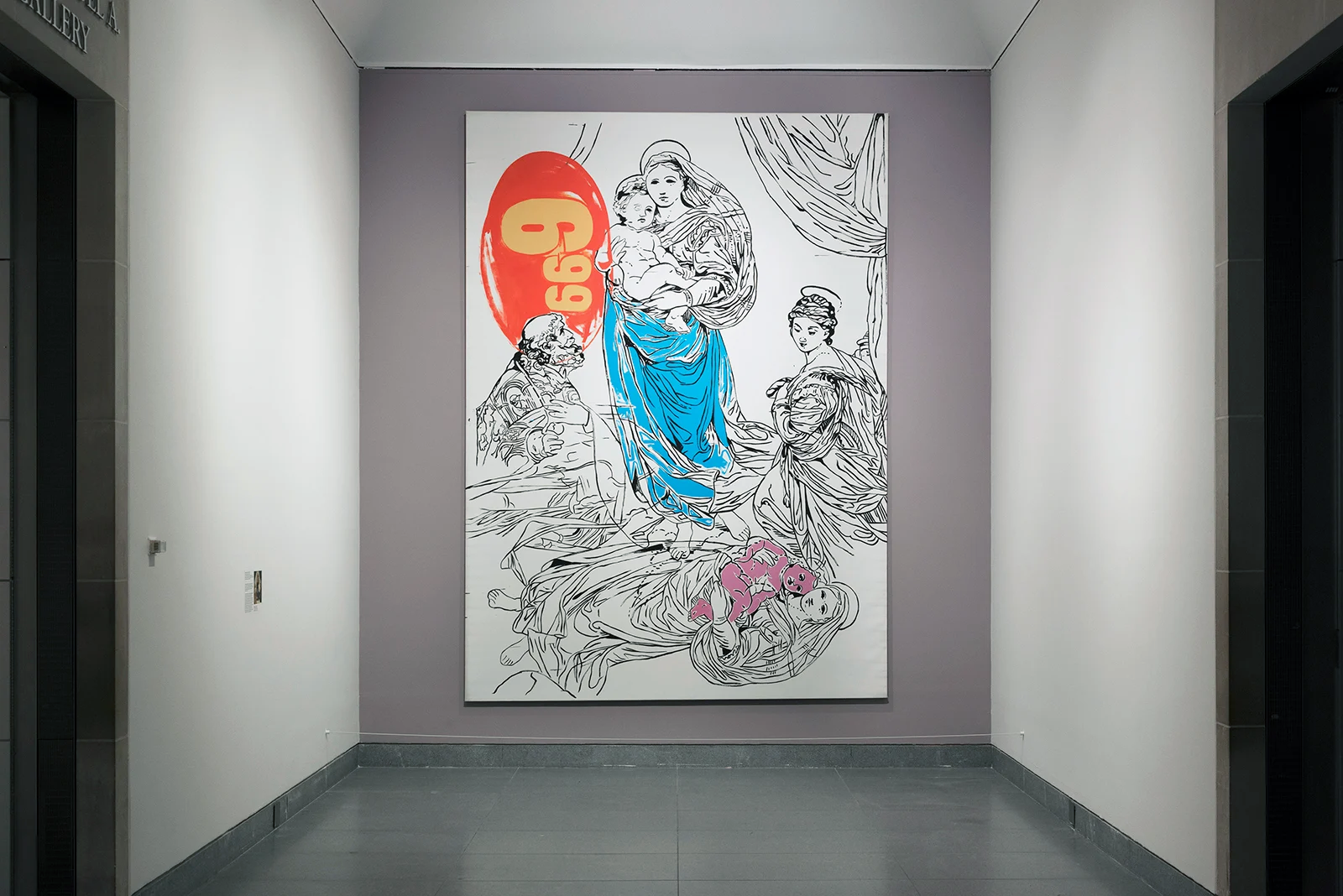
Keith Haring
Keith Haring was an urban American graffiti artist and social activist. He created bold line drawings, and his work frequently appeared in New York City's public spaces, both overground and in the corridors of the subway.
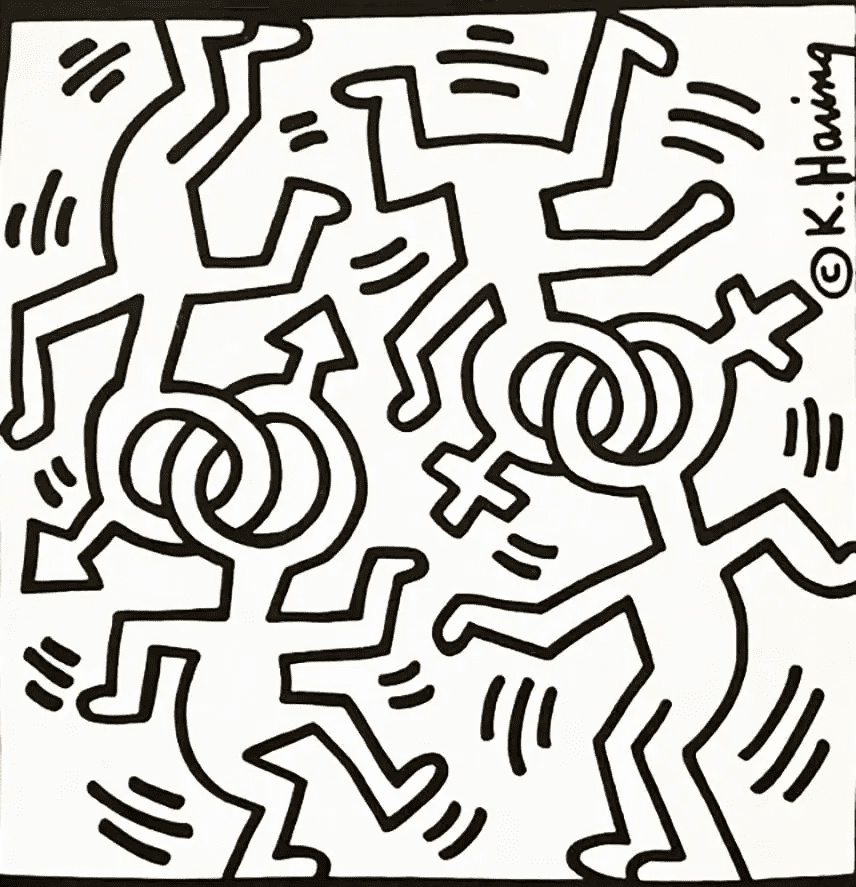
He was an artistic comrade of the fellow artists Kenny Scharf and Jean-Michel Basquiat; Haring lived and worked in New York, where he attended the School of Visual Arts—a private college of art and design—in the late 1970s. Born Keith Allen Haring on May 4, 1958, in Reading, Pennsylvania, he learned to draw as a child and was particularly interested in cartoons and pop culture. Haring's extraordinary career remained short.
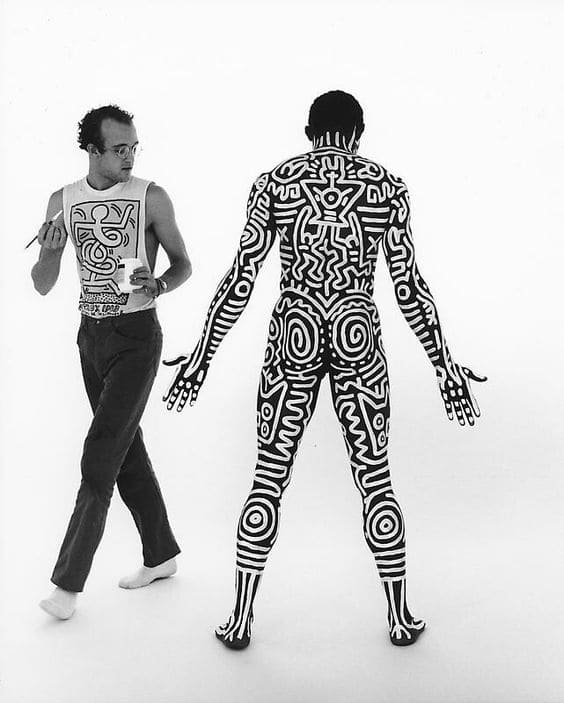
In 1988, Haring was diagnosed with AIDS. He died at 31 years old on February 16, 1990, from the consequences of the immunodeficiency disease. Until his death, he was committed to using his art to raise public awareness of the disease. Haring was openly gay and depicted queer love and sexuality in his artworks.
Jean-Michel Basquiat
Jean-Michel Basquiat, a neo-expressive painter and black gay artist, marked the 1980s. He is famous for his primitive style and collaboration with pop artist Andy Warhol.
Jean-Michel Basquiat was born in Brooklyn, New York City. His mother was Puerto Rican, and his father was Haitian. His cultural heritage inspired him, and he often incorporated Spanish words into his artwork.
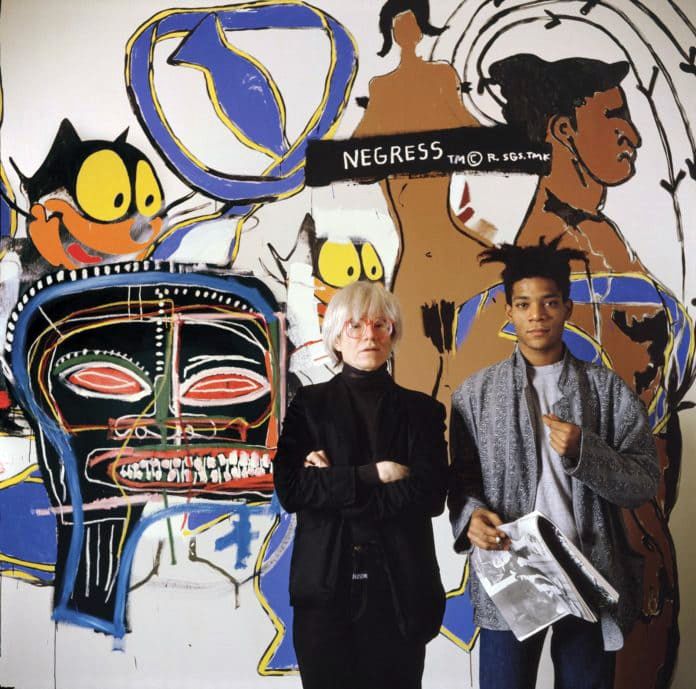
His former girlfriend, Suzanne Mallouk, who financially supported him, described his sexuality as:
Basquiat used social commentary in his paintings to question himself, his Latin and black identity, and attack power structures and racist systems. His visual style was highly political and direct in his critique of colonialism and his support of the class struggle.
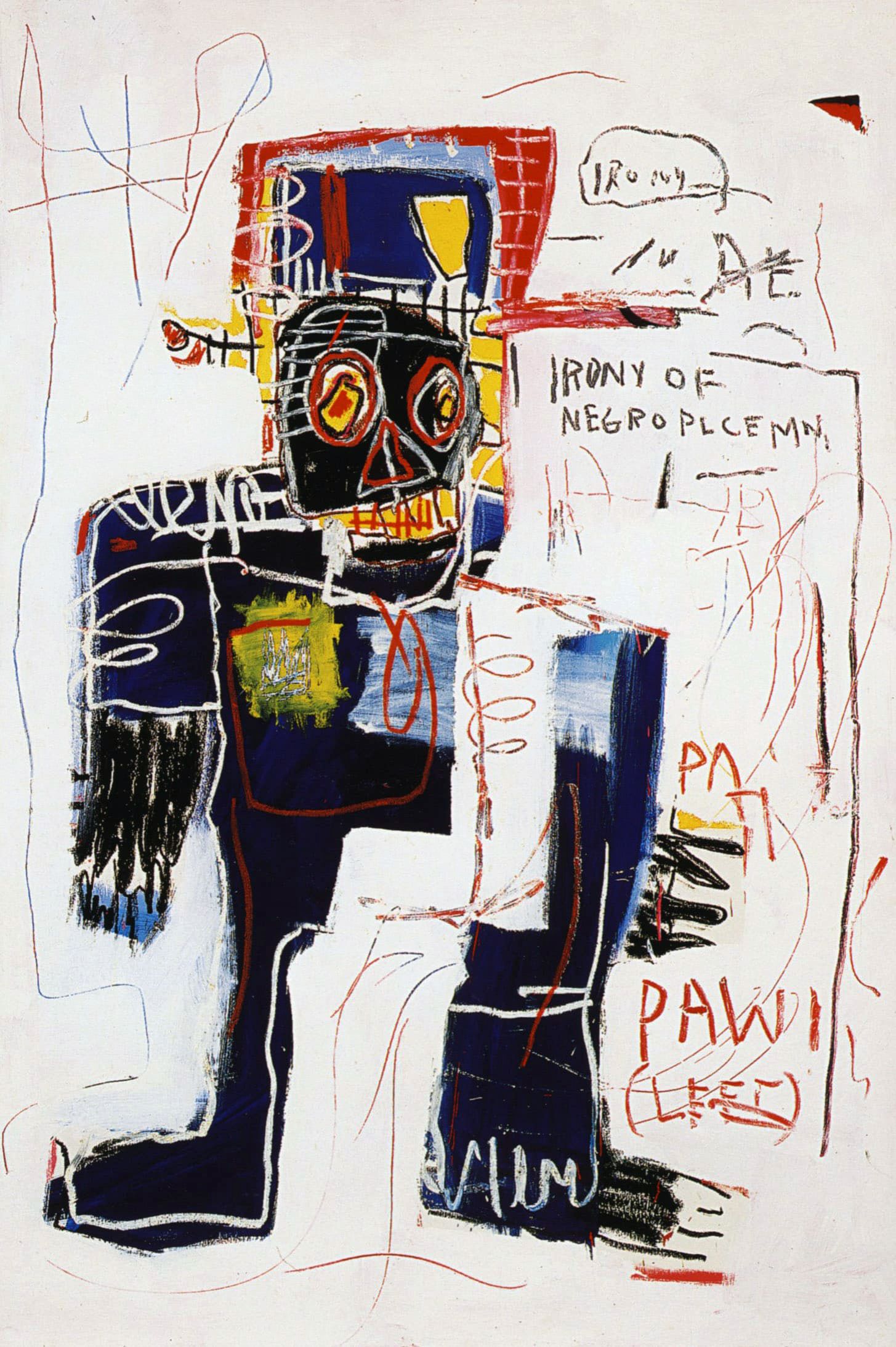
Queer art today
Alex Baczynski-Jenkins
Polish performance artist and choreographer Alex Baczynski-Jenkins (Poland/U.K.) explores themes of desire, vulnerability, and collectivity. His work is concerned with mediating queer embodiment and relationality through empathy, affect, and intimacy choreographies. He views queerness as a process in which the choreographic frame of reference fluctuates between structure and impermanence.

Christina Quarles
The motivation to create an ambiguous form in her paintings stems from her own experience of being in a body that is not always fitting into the heteronormative, patriarchal, white, Western ideals that structure daily life, especially as an obese queer woman born with a black father and white mother. Her experience with ethnicity, which she has always found to be multi-layered rather than "mixed," has been particularly influential in her understanding of the simultaneous, often contradictory nature of ambiguity and how this overabundance of information distinguishes ambiguous illegibility from diffuse illegibility.
What she finds most potent about art is its potential to engage people in conversations they didn't know they could have. Her paintings are meant to be a refuge for those who face ambiguity daily and a means to unlock the potential for ambiguity in those who do.
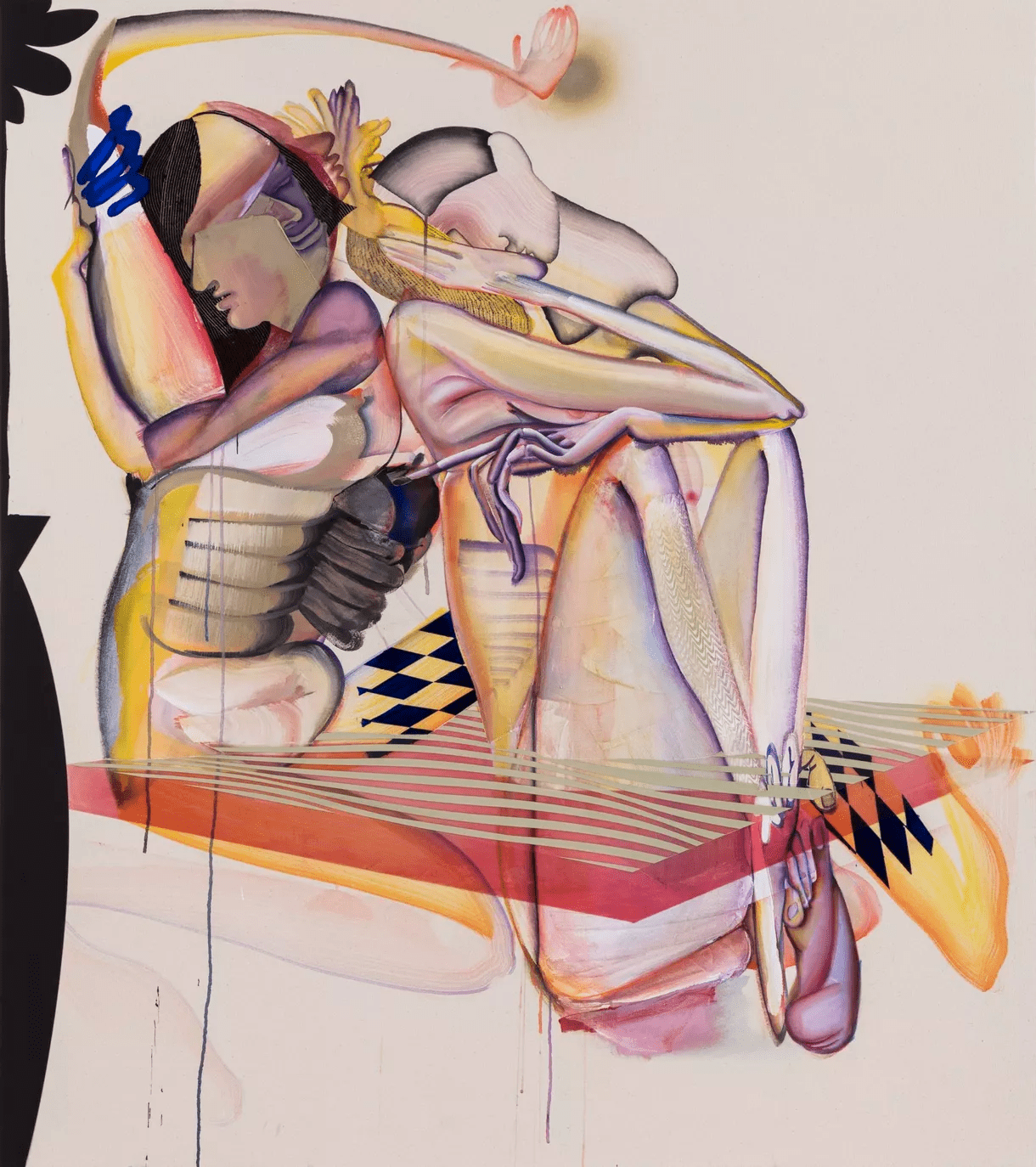
Austin James Smith
It's difficult for many people to view art outside the disciplines of painting, drawing, and sculpture. The queer contemporary artist Austin James Smith challenges these concepts by using his face as a canvas for his dark but playful art.
His artwork created with makeup, jewels, and everyday items on his face is temporary, but he can make a lasting impression by photographing it.
Smith's Instagram presence has skyrocketed his popularity, and he's very grateful to live in New York, where he's free to express his creativity - a luxury amplified by his latest collaboration with a Russian artist.
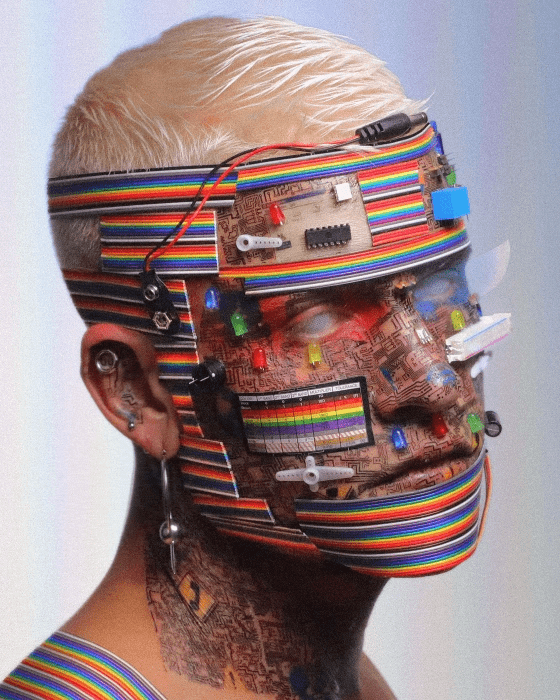
Wrapping up
Queerness has been a part of human sexuality since the dawn of humanity.
Depictions of it in art are visible throughout the history of human art; some depictions were apparent, some more hidden due to societal restrictions. Nevertheless, this part of human life maintained a consistent place in the art history of humanity even through difficult times when societal discrimination was rampant.
We hope we can inspire you to start or continue your creative journey, experiment, and express your creativity freely.
If David Hockney can start creating famous drawings from scratch at an advanced age with an iPad, why don't you download Linearity Curve (formerly Vectornator) for free and start creating your artwork?
Share your creative masterpieces with us on our social media or community art gallery. We'd love to see your designs.
Jumpstart your ideas with Linearity Curve
Take your designs to the next level.
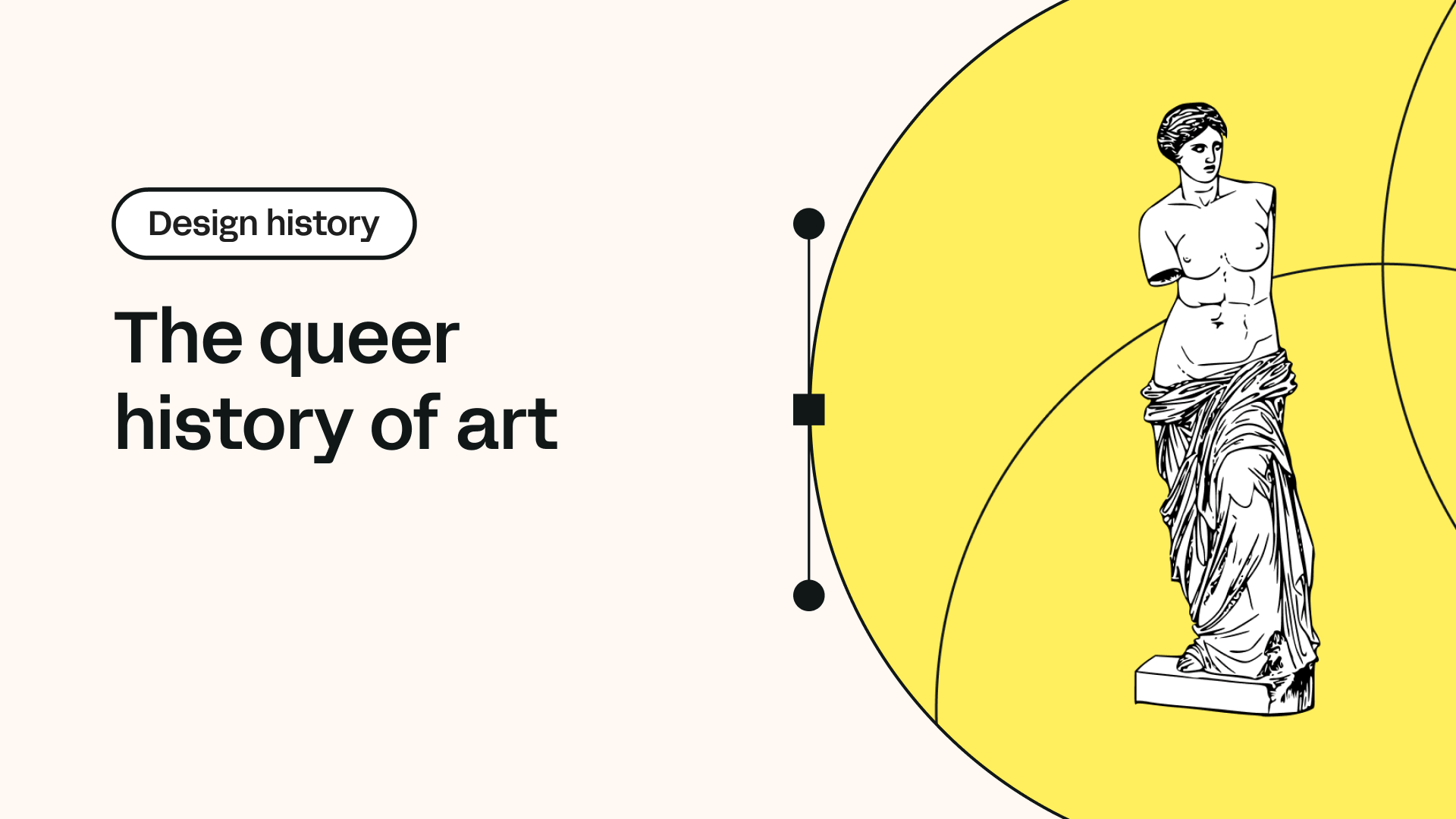
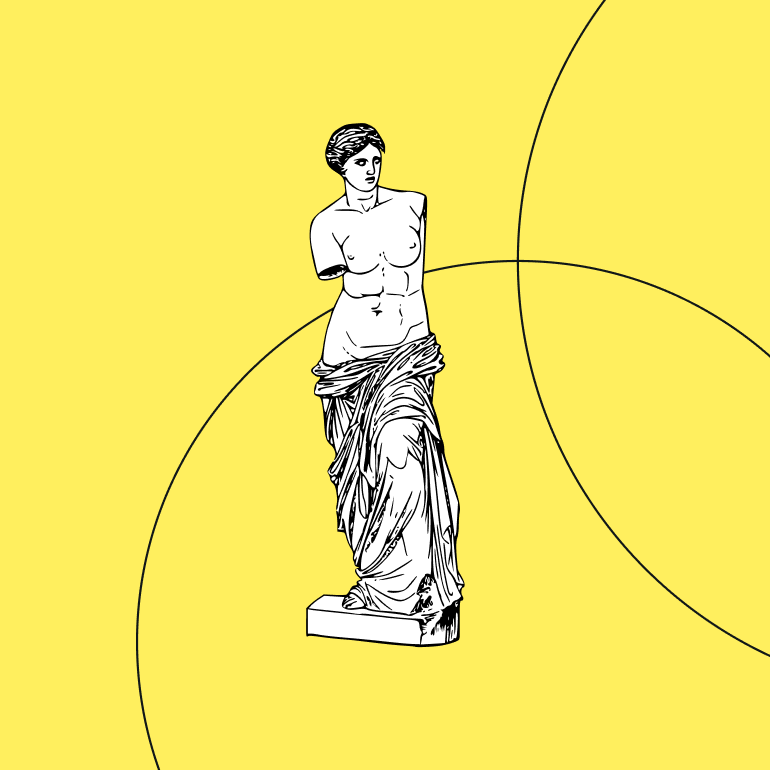
Share this!
Marion Gerlinger
Marion is a contributing writer to the Linearity Blog.


:quality(75))
:quality(75))



:quality(75))
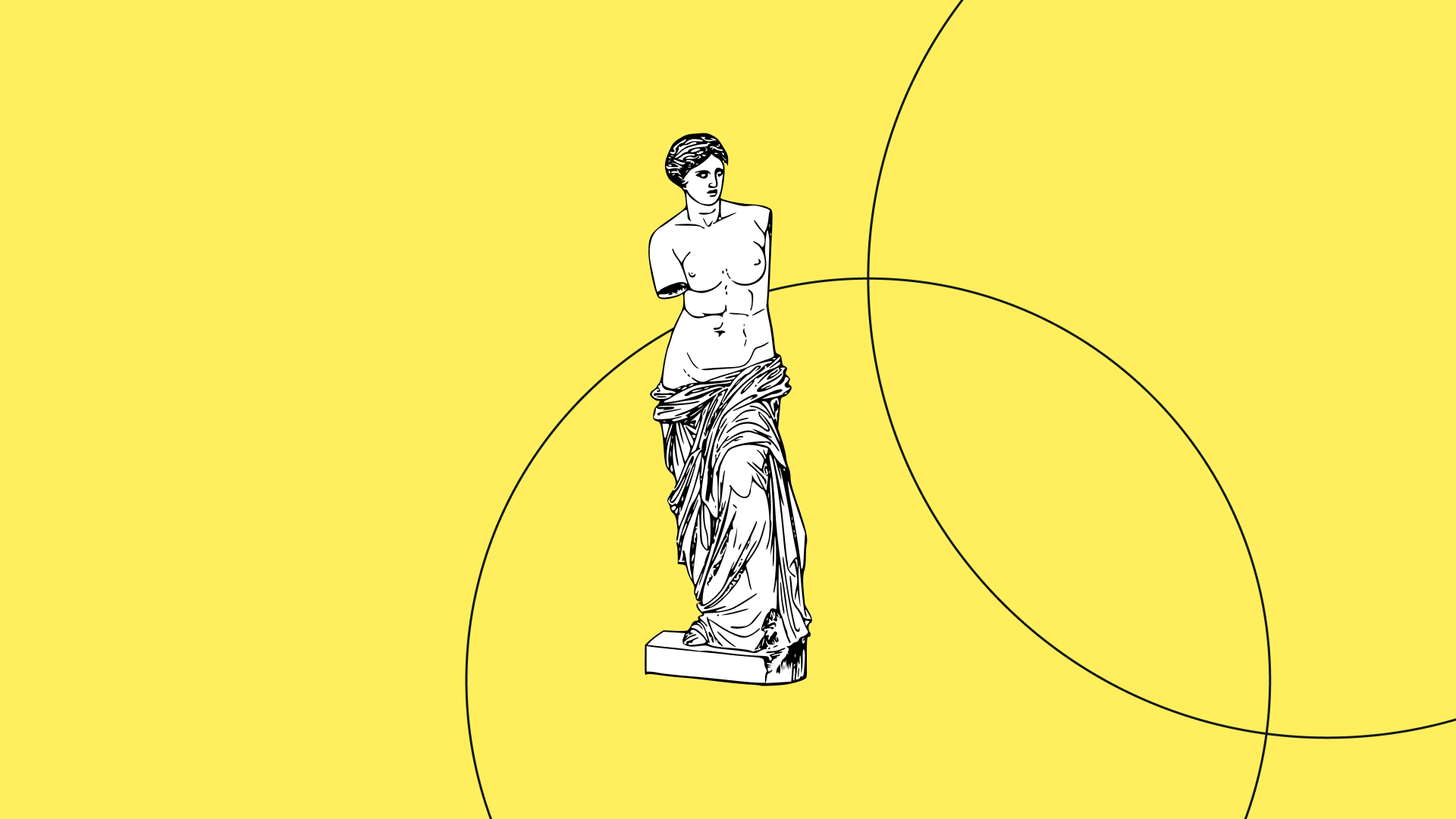
:quality(75))
:quality(75))


